rangifer’s diary: pt. cx
An all too brief polemic against the post-Big-Bangification of nominally “pre-Big-Bang” MapleStory
The concrete focus of this essay will begin with MapleLegends’s recent changes to the damage formula for certain 4th-job mage skills. However, in spite of this, the actual focus of this essay is not on said changes, nor even on MapleLegends in particular; rather, the principles laid out here apply to nearly every MapleStory private server (MSPS) that is based on a pre-Big-Bang retail version of the game.
The strategy is simple: start with the most concrete & most specific discussion, & then gradually zoom out until we can reach more abstract conclusions. I promise that we are going somewhere valuable over the course of this essay, & indeed, this essay can be thought of as a kind of prelude to an as-yet untitled work that I don’t plan on writing in earnest until I decide to put my diary aside.
Although I can promise that, if you like MapleStory, you’ll be able to get something of value from this essay, I cannot promise that you’ll like this essay enough to actually extract it. If you do like it, though, then I recommend also reading its companion essay (after finishing with the present essay, of course): the “Insurance against the explosion of the Earth” section of pt. cxxii.
Para, CL, AR, & co.
MapleLegends’s recent balance changes only affect the following skills:
- Paralyze (Para).
- Chain Lightning (CL).
- Angel Ray (AR).
- Fire Demon.
- Ice Demon.
- Big Bang (BB; not to be confused with the Big Bang update, which is the sense used throughout this essay!).
Most notable is that these are all exclusive to the various 4th-job mage classes: F/P archmages, I/L archmages, & bishops.
Because the damage formula for these skills was revised twice, we have three formulæ to deal with: the original pre-BB formula (“rev. 1”), MapleLegends’s first revision (“rev. 2”), & MapleLegends’s second revision (“rev. 3”) — the last of which is current at the time of this writing. In this order, the formulæ are as follows…
Formulæ
ℹ️ Actually reading these formulæ is optional! And I don’t wish to inflict it upon my reader!! These are here for reference, & you may skip ahead to the “Assessing rev. 2” section, if you like.
In the following formulæ, let:
- be a random variable representing the raw magic damage dealt, uniformly distributed over the interval .[1]
- be the attack of the spell being cast, as listed in the relevant skill level’s description, usually referred to by the phrase basic attack, or simply attack.
- be the mastery of the spell being cast, as listed in the relevant skill level’s description.
- be the PC’s total magic attack (total MAtk).
- be the PC’s total INT.
- be the PC’s base INT.
- be the PC’s base LUK.
- be the PC’s level.
Rev. 1
Rev. 2
Where:
Rev. 3
Where:
Dear god
Oh boy, that is some pretty gnarly stuff. I cleaned these up a good bit, & in any case, MapleLegends’s presentation of the formulæ is with each one written in a single line in a kind of source-code-like format, so this is a huge step-up — trust me.
Assessing rev. 2
I won’t be saying all that much that’s specific to rev. 2, because it was quickly replaced with rev. 3, & for obvious reasons. Rev. 2 is so painfully bad that it instantly noticeably broke the skills that it applies to. As soon as the relevant patch notes dropped — which was before the game was even live, mind you — I realised that it was effectively making the relevant skills useless for any archmages/bishops whose TMA wasn’t vaguely around that of a well-geared pure-INT mage of the same level. And indeed, when I tested in-game on my I/L archmagelet cervine, I found that my CL dealt 1 damage even to targets with trivial MDef (e.g. Orange Mushrooms).[2]
But the breakage is, of course, not limited to odd-jobbed mages.
Ramping
This is — partially — a result of one of the phenomena that also applies to rev. 3, whereby the ill-advised use of subtraction effectively throws a prickly nonlinearity into sharp relief — but only sometimes. The basic idea is that mages who’re closer to the “actually dealing damage” threshold — or as I like to call it, “you must be this tall to ride the Chain Lightning” — are disproportionately penalised by the terms that contain , & this effect is amplified by monsters with higher MDef.
The “prickly nonlinearity” basically arises from the fact that, in most places, we cannot deal with negative numbers, & so they get clamped. This is normal in cases where DEF (of a monster, or of a PC) is concerned, but now — with rev. 2, & to a lesser extent, rev. 3 — we get to see it in action for realistic raw damage range calculations. The result is something that I like to call the ramp effect, because it turns something that we naïvely expect to be linear into a kind of ramp function[4].
What makes this nonlinearity so “prickly” is twofold:
-
Because the ramp is virtually a linear function that has been unexpectedly truncated, values near the inflection point decrease — in relative terms — precipitously as they approach the inflection point. Put simply: , but . We’ve made an oopsy with the origin, & unfortunately, we’re not in an affine space…!
-
The behaviour of the output is now noticeably not differentiable. Note that, in this context[5], differentiability is actually a relatively weak property, because higher differentiability classes are not exactly exotic; for instance, all polynomials are infinitely differentiable.
In particular, when talking about noticeable “nonlinearity”, what I really mean is actually narrower than the usual sense. My sense is closer to “non-differentiable”, because a differentiable function is — by definition — locally linear. But we can frequently do even better than that. Consider , which is a common form in raw damage calculation. This is a monomial of degree two, & two is neither one nor zero; therefore, is “nonlinear” in the usual sense. However, the actual result is a hyperbolic paraboloid, which is a doubly-ruled surface, thus making “doubly linear” (if you will) in a very real geometric sense. Although the geometry itself doesn’t generalise beyond degree two, the basic idea can still be generalised to more than two variables, & also to arbitrary natural number powers via a process of making alien copies of each single variable: is “alienated” to .
Expect that, throughout this essay, I will be using terms like linear, nonlinear, nonlinearity, &c. in this specialised sense.
Uncanny non-monotonicity
But the prickly nonlinearity itself is not the only problem facing the 4th-job mage here. In the “Non-monotonicity per sē” section of pt. ciii of this diary, I demonstrated that serious non-monotonicity in character progression in MapleStory is somewhat unusual, & when it does occur, it’s limited to only a small handful of very specific elements of the game. Moreover, MapleLegends in particular has made multiple attempts to remove some of these sources of serious non-monotonicity, e.g. revamping the skill progression of both Burst Fire & the Crusher skills.
With rev. 2 — and, as we’ll see, rev. 3 as well — however, this kind of non-monotonicity has made its way into damage calculation itself!! In the case of rev. 2, it’s more or less staring us in the face: the mere fact of levelling up is enough to significantly lower the mage’s damage output. Now, clearly, the idea that the PC gets “weaker” as a result of earning “too much” EXP is preposterous at absolute best, but we also need to bear in mind that introducing serious non-monotonicity into damage calculation per sē in general is equally preposterous.
Assessing rev. 3
We’ve now seen why rev. 2 is disastrously problematic for, at the very least, a large portion of the 4th-job mage population — the fact that leech-givers don’t care about the affected skills notwithstanding. We’ve also got our bearings somewhat when it comes to what to look for in these tangled formulæ. With these things in mind, we can move on to analysing rev. 3, which is the less-embarrassing hotfix replacement for rev. 2.
We’ll do this by proceeding from one aspect of rev. 3 to another, increasing in seriousness & depth as we go.
Logarithms
ℹ️ If you’re allergic to mathematics, then you may skip ahead to the “Overfitting” section.
The reader will have noticed that both & contain a term.
One strange thing about this term immediately stands out: is the same as just , because , because for all mages. I don’t claim to know how the function got in there, but it does demonstrate at least one thing: just because an explicit nonlinearity — indeed, yet another ramp function! — is nominally written into the formula does not mean that the nonlinearity is meaningfully evinced. In this particular case, this is for purely logical reasons, but this is not necessarily always the case.
Perhaps slightly more interesting, however, is the use of a logarithm. This is at least strange, but I also want to argue that it’s potentially misleading for everyone involved.
Asymptotically, a very elementary result is that any exponential function — for any base strictly greater than one — dominates any polynomial of any degree. Symbolically,[6] in terms of a single variable , we have , for any constant , & any constant real number . Although elementary, this is perhaps a surprising result, considering that this applies even to polynomials of ridiculously high degrees like e.g. 100. This is pretty wild stuff, given that, in damage calculation, functions that dominate polynomials of degree two[7] don’t even enter the picture!
Now, consider the fact that logarithms are, by definition, the inverse functions of their corresponding exponential functions. Therefore, logarithms grow as slowly as exponential functions do quickly. Thus, if we use logarithms in damage formulæ, we are introducing a strange asymptotic asymmetry: we allow the consideration of the inverses of our polynomials — which are linear functions, & functions that grow as square roots, respectively[8] — but not the inverses of our slower (read: sublinear) functions!
This might not seem like a terrible thing, but soft-Õ notation gives us a hint as to the problem here: in this relatively commonplace notation, ,[9] for any constant . This is not an abuse of notation; this is a genuine equality. (Poly)logarithmic functions simply are effectively constant for many practical purposes.
The result is that the use of logarithms in a damage formula is — likely, needlessly — asymmetrical, & gives the false sense that the formula is really “scaling” with whatever the argument to the logarithm function is.
Overfitting
A broader problem with rev. 3 is what I’m going to refer to as the overfitting problem. This is related to the logarithm problem discussed above, & will also be very relevant later on. In short, both rev. 2 & rev. 3 are good examples of what happens when formulæ are overengineered to fit extremely specific goals:
- Needlessly arcane constructions,
- bizarre behaviours (see the “Nonlinearity & non-monotonicity” section below),
- & overfitting to the point that broken game-mechanical notions are inextricably baked into the formulæ themselves (see the “Accoutrements” & “The inenarrable ‘meta’” sections below).
This problem initially presents itself (at least, in these cases) as an immediate glazing over of one’s eyes upon directing them towards the formulæ. This inscrutable nature is indeed a result of the overfitting, but the actual implications are much more dire.
One of the other, less obvious indications of overfitting is the use of inputs that are not otherwise found in raw damage calculation; in the cases under consideration, viz. , (not to be confused with ), & (not to be confused with ). Although we’ve already seen why the use of is disastrous, there’s also something deeply suspicious about the direct usage of base stats.
As players, we clearly expect ordinary damage formulæ to take our stats into account, and so we strive to increase the relevant stats however is possible, & ideally, optimal (given some target of optimisation). The direct usage of base stats, then, invasively dissects this process, openly wondering precisely which component(s) of our internal organs are responsible for our STRength, our INTelligence, &c.. The stat itself is, then, no longer its own entity, as the damage formulæ are more concerned with what type of character we are, rather than our stats — & the process is consequently stripped of a good chunk of its behaviourism.
Nonlinearity & non-monotonicity
In the “Assessing rev. 2” section above, I went into some detail describing the nonlinearity (in my sense) & non-monotonicity of rev. 2 that essentially results from overfitting. Like with rev. 2, rev. 3 also exhibits these thorny issues for virtually the same reasons.
We can see in the definition of that one of the three terms is . This is — you guessed it — yet another ramp function. Although this does introduce some of the same issues raised in the “Ramping” section above, in this case, the real purpose of ramping is actually damage mitigation — & no, I don’t mean “damage” as in magic damage, I mean the damage to the game caused by silly formulæ!
The problem is, of course, that this term is a source of explicit non-monotonicity: although we don’t have the embarrassing problem of rev. 2 whereby mages lose their damage output in the simple act of levelling up, we do have mages losing their damage output in the still quite simple act of spending AP (or using APRs, for that matter). Even in this humbly mitigated form, there are still considerable implications:
-
Although mitigated, the effect is still there, and thus 4th-job LUK mages & LUK-y mages stand to be impacted in unexpected ways.
-
Another form of mitigation here is not just the ramping, but also the very selective choice of skills that this formula applies to.
This is most certainly not the only bespoke raw damage formula in MapleStory — see, particularly, the “Heal” section of pt. cviii of this diary — but when we see other such examples, we notice that the bespokeness is generally based on the nature of the skill, rather than being applied ad hoc for broad “game balance” reasons. The result is that, in most MapleStories, bespoke damage formulæ are applied uniformly to skills of a certain nature, without regard to largely orthogonal factors like e.g. what level of the game (in this case, grade[10]) those skills are applicable to.
And if we hypothetically undo this clearly ad hoc mitigation, we see that low-level PCs are disproportionately affected by this ramp term, to the point that rev.-2-like behaviour can reasonably easily occur.
-
Introducing a ramp function for this purpose, & being forced to choose an arbitrary constant as one of the arguments to the function, are additional good examples of the overfitting problem as laid out in the “Overfitting” section above.
-
And of course, this is a source of both genuine non-monotonicity & nonlinearity.
Accoutrements
But why? Where are we getting from? ? The number ? Within the patch notes lie the answers, although we’ll need to do a bit more thinking to get at what’s really going on here (emphasis in the original):
- Previously, a large portion of a mage’s damage came from purely their level. The strength of your gear or the potion you used felt like they had diminishing returns.
- Now, how strong your gear is and the type of potion you use will matter far more than before.
So it’s that simple? The strength of the mage’s gear & the MAtk buff that they used “felt like they had diminishing returns”…
The immediate concern here is that the problem as posed by the above quotation might be falsified to begin with.
Pretext…?
For starters, we can see clearly in the “Rev. 1” section above that the vanilla pre-BB raw magic damage formula is fairly straightforwardly quadratic in . This implies that an increase in the mage’s TMA by results in an increase in the mage’s raw magic damage by an amount that is quadratic in . Thus, although it certainly is true that there are “diminishing returns” — as a result of the fact that the increase is also linear in the mage’s previous TMA value — this is more or less just a consequence of being high-level — read: further away from zero, and also closer to hitting both soft & hard[11] upper limits — & the actual increase is guaranteed to be generally valuable no matter what.
As players, we already understand & expect that, as our gear, level, & other resources approach perfection, the increases that we work just as hard — & usually, harder — for will make smaller relative differences (“it adds up”); after all, we already deal a shitton of damage, certainly enough to do any game content that we like with an appropriately-sized & appropriately-levelled party. Do you even know how much more expensive an equipment item with [12] [insert very relevant stat here] is than one with ? Oh my god. Moreover, the fact of the matter is that, by the time that minor TMA optimisations truly matter to the player, their PC already outstrips their previous selves — especially lower-grade[10] ones — by literally many orders of magnitude. What happened to those orders of magnitude…?[13]
Maybe not!
But okay. Let’s accept that what we had before is just not quite gonna cut it — that’s fine. We know that each point of INT passively increases TMA by 1, we observe the consequences thereof, & we’re not happy about it! That’s honestly understandable in some ways, considering that these two things (viz. INT & TMA) tend to scale up in a way that is boringly, or perhaps frustratingly, coupled together. It would seem, then, that the tools required to improve our situation are sitting right in front of us:
- Passive TMA is just too much? The “1” in “passively increases TMA by 1” doesn’t have to be 1; it’s just another constant. Setting this constant to — to give just one example — 0 would align this mechanic most closely with physical attackers, who also do not have ATK passively conferred upon them by their main stats.
- Rev. 1 isn’t quadratic enough, or is too heavily influenced by the component? The constants are all right there, waiting to be infinitely tweaked ad nauseam.
- Optimising for the barest amount of LUK necessary to wear that fun mage gear is taking too much out of the mage’s damage? Consider making LUK an actual secondary stat for mages; after all, almost everyone else already had secondary stats this whole time! It wouldn’t even be the first magical attack to scale with LUK!![14]
That’s my seamster’s job
This last point is getting much closer to one of the reasons why we see the zany behaviour of rev. 3 (emphasis in the original):
The basic components for the mage damage formula is:
(baseInt × gearTMA) + baseInt + gearTMA,
Where baseInt is the stat points you have in Int and gearTMA is all the Int + Magic Attack from your gear.
Rather than really changing the damage formula, the intent is to perform even more invasive dissection (see the “Overfitting” section above) to spuriously inspect what’s going on inside of the PC’s stats. The justification for the ramp function, & the constant used within it, then, is apparently simple (I’ve corrected some typos in the following quotation):
gearTMA is calculated as Magic − baseInt − baseLuk. On a basic level, this provides separation between base stats and magic attack obtained through gear, similar to attacking classes. So, the quadratic term baseInt ⋅ gearTMA would be something you might see like Luk ⋅ WAtk for Nightlords.
The −baseLuk modifier is recognizing that Luk mages would typically trade off baseInt for more magic attack gains from gear, so a 0.5 coefficient is applied to not make Luk mages the default build choice (without −baseLuk), but also not destroy higher Luk mages (if 1× coefficient were used). In effect, similar TMA should result in close to the same damage between base Luk and Lukless mages. There is also a min(baseLuk, 100) that caps this effect to 100 base Luk, since there is no gear progression after elemental staff 5 thru 8, so any builds that might add even more base Luk shouldn’t continue to be adversely affected by this.
This is the overfitting problem in spades. The focus here is on overfitting to equipment item — & scroll — availability (although the hint at balancing relative to nightlords specifically will turn out to be relevant in more ways than just the fact that TT has no secondary stat…).
But the reader likely already realises that this is exactly backwards: equipment items — and buffs from both skills & consumables, mind you — exist to empower the PC’s abilities, not to be the absolute structure that those abilities exist to conform to!
We’d imagine that, given all of this kerfuffle about mage gear not scaling well enough, & quite a bit of agonising over Mages That Do Not Have Four Base LUK™, we’d take a second look at said gear. We have the extremes of nude mages (read: 4 base LUK and/or low base INT), & fully-clothed mages (read: INT mages that have enough base LUK to wear full outfits of level-appropriate gear). We also have many mages that are somewhere in between these two extremes, in one way or another. So perhaps we want nude mages to suffer the perils of fighting formidable monsters & bosses whilst in their birthday suits. Or perhaps we want the choice between nudity & non-nudity to be an interesting one that players are encouraged to ponder (this is MapleLegends’s stated approach). Or perhaps we want to go further, encouraging players to make tradeoffs between the stats given by conflicting equipment items, & to play 4D gear Tetris™.
In any of these cases, & also in any case where we’re worried about mage gear not scaling well enough, we’d take that second look at gear itself:
- Does mage-only gear (& to a lesser extent, common gear) give enough LUK/tAVOID as it is?
- Does mage gear give enough INT/MAtk as it is?
- Does mage gear give enough of other valuable[15] stats like WDef, MDef, maxHP, maxMP, SPEED, & JUMP?
- Are LUK requirements on gear too high? Too low? Are our nude mages too privileged by their equipment requiring ≈4 fewer LUK than they have…?
- Are the elemental boosts on certain weapons too strong? Too weak? Not widespread enough?
- Do the Heal skill[14] and/or AVOID formulæ teach us anything about how a mage’s stats can profitably interact with their gear without coupling the two to one another?
- ⋮
The inenarrable “meta”
The expression has invaded all human activities: grammar should now be called meta-language; I recently heard about a meta-movie; tomorrow the constitution will be called the meta-law… We can only hope that the promoters of the meta will be paid back in meta-money!
“Meta” is problematic since it is too ambiguous: typically, take the Tarskian definition of truth — it is currently assumed that and exists before . But a more perspicuous analysis, in the ludic style, would say that truth is nothing but a convenient way to reflect properties of formalism: typically the reflection schema only works when the syntax enjoys cut-elimination. It would therefore be more prudent not to try to make a hierarchy between and and, that is, to stick to the “beside” meaning (“paraphrase”) of “meta”.
Personally, I never use this expression in front of children.
ℹ️ Think you know what the “meta”-game is? Just keep reading — trust me. Ostensibly knowing what the “meta”-game is is the basic standpoint from which this essay starts.
But that’s enough beating around the bush. We went to the patch notes for answers, & if we’re honest, we wound up with more questions than we started with.
Well, perhaps all of this overfitting & general tomfoolery is in service of something a bit less concrete. When it comes to changes that have strong game balance implications — such as this one — the actual target of the changes is not the game itself (which some have been so bold as to refer to as “MapleStory”), but rather, the inenarrable 👻metagame👻.
To give an idea of the “meta”-game’s relation to the actual game in this particular context, consider your own physical injury. You likely hope that someone who practices medicine can identify, diagnose, treat — and, if you’re lucky, cure — what ails you. Importantly, this process absolutely requires that the practitioner(s) have as their focus & object the physical parts of your body that are involved in the injury, & moreover, that they understand how those parts interact not just with one another, but also with the rest of your body, & with your lifestyle. If you’re lucky, the case is simple; perhaps you broke your leg, & so your leg is treated. The “meta”-physician, then, may or may not understand that your leg is broken, or even what that means & its implications, but has a solution anyway: with their favourite variety of alternative medicine (better known as pseudo-medicine or simply quackery), they can realign & encromulentify[16] your “meta”-leg, & with your “meta”-leg aligned with the “meta”-chakras throughout the rest of your “meta”-body, you’ll be right as rain in no time.
And hey — it works! So-called “alternative medicine” is widely practised throughout virtually the entire world, & doesn’t show any signs of slowing down, even as the advancement of medical science marches onwards. The placebo effect & other forms of psychological suggestion are very powerful things, & moreover, the “alternative” “meta”-treatments are still physical operations that have physical effects. So unless you’re just drinking “homeopathic” tap water instead of normal, non-“meta” tap water, those pseudo-treatments have very real effects — even if those effects are not usually what we want, or are even actively harmful.
Likewise, the “metagame” imagines that the game is not really the game, but is instead some other game worthy of the letters ⟨m, e, t, a⟩ — not a physical body, but a universe of chakras that correspond to parts of the physical body. Thus, there really is — notionally — a relationship between the game & the “metagame”, by definition: the objects that inhabit the “meta”-universe are defined to notionally correspond to actual things in the real game. The problem, then, is that the construction of these objects (in the pseudo-medicine analogy: chakras, acupuncture points, &c.) is illusory, & the “meta”-relations between them (in the pseudo-medicine analogy: the subtle body, meridians, &c.) even more so. Even if we try to be as charitable as possible, & argue that these things are not necessarily “illusory”, we still run headfirst into the classic “alternative medicine” problem whereby no one — not even its practitioners — agrees upon large parts of the ontology.
This type of system is seemingly tenable, but only because it recruits its disciples & its passive observers by narrowing the scope of the game in a process of intensified neglect. It should be fairly clear to the reader that, even if there are “meta”-games normatively informing how games “should be” or are “best” played, then MapleStory would not be one of them. After all:
- MapleStory is not a competitive game (notwithstanding the fact that any game — even a single-player one — can be made competitive if one tries sufficiently hard);
- it’s open-ended, providing little in the way of meaningful “win” conditions other than artificial level caps (in MapleLegends, viz. 200, but in general the number is arbitrary) or similar;
- & it not only supports, but is actively home to, an enormous variety of different — & sometimes, wildly different — playstyles.
The “meta” rears its ugly head
But this is merely an abstract introduction, necessary before we uncover the insidious “meta” of rev. 2 & rev. 3, of MapleLegends more broadly, & of nominally pre-BB MSPSs even more broadly.
The “stats don’t matter” principle
One of the common patterns that we’ll see is something that I like to call the “stats don’t matter” principle. In this case, the principle is forked into two prongs:
-
Overfitting to circumvent the honest & straightforward usage of stats (quoting myself here; note that this also applies to rev. 2’s usage of ):
The direct usage of base stats, then, invasively dissects this process, openly wondering precisely which component(s) of our internal organs are responsible for our STRength, our INTelligence, &c.. The stat itself is, then, no longer its own entity, as the damage formulæ are more concerned with what type of character we are, rather than our stats — & the process is consequently stripped of a good chunk of its behaviourism.
This kind of overfitting makes sense insofar as we are operating not on the game, but on the “metagame”, & thus are not necessarily beholden to basic game mechanics.
Stats thus “don’t matter” not in a literal, direct sense, but rather in the sense that they may be freely bypassed or tunnelled through, as they have no existence of their own.
-
Making rigidly strong assumptions about game content, playstyles, character builds, the players’ goals, &c., & then baking those into the game’s stats directly.
This makes sense insofar as we are operating not on the game, but on the “metagame”, & are thus allowed to assume that all players will slavishly obey the will of the “meta”.
Stats thus “don’t matter” not in a literal, direct sense, but rather in the sense that they are already inviolably prophesied by the “meta”, & thus any notion that they could be otherwise is futile at best.
Preservation
But maybe “futile” is too strong of a word. Even a disciple of the “meta” is capable of articulating — albeit feebly… — the ✨barest✨ concept of creativity. The third stated goal of rev. 3 is as follows:
- Preserve off-meta builds
…But the phrasing here is so revealing that it’s almost physically painful to read.
I have a feeling that “off-meta builds” is actually just a euphemism for odd jobs, but in any case, it’s clear that the set of all things not “meta” is actually vastly broader than that.
The real point, though, is this: the word “[p]reserve” here means exactly what it sounds like. The “meta” is the true version of the game, but we are willing to make concessions to preserve non-“meta” things, like so many antiques in a museum.
A process of intensified neglect
What do I mean by “narrowing the scope of the game in a process of intensified neglect”, though?
Part of this neglect can actually be directly blamed on Necksawn. As we observe retail versions of MapleStory over real time, from year to year, we see that later versions often have a habit of trampling those that came before. This process is uneven, & occasionally we even see responsible behaviour when we’d usually expect more trampling. Nevertheless, what this amounts to is essentially a piling up of contradictions: the trampled content, mechanics, & aspects of the game are neither gone, nor truly destroyed, but instead continue on in a state of broken neglect, related — but only half-related — to the rest of the game.
We understand, of course, that /ˈnɛk.sɒn/[17] is a large videogame publisher that is really just trying to squeeze those delectable simoleons out of its “free-to-play” audience. The response, then, is to create private servers — MSPSs — that remove the pay-to-win elements, & repair the clumsy choices that Negzun made in their quest for the big ₩. However, what actually happens is generally — & unnecessarily, mind you — split along a false dichotomy, which we’ll later see. Both arms of the false dichotomy effectively continue Neqqsaan’s neglect, albeit one more obviously than the other.
MapleLegends is almost always faithful to this false dichotomy, although it chooses between one arm of the dichotomy & the other capriciously, ostensibly depending on the particular concern in question. We’ll first consider the arm that is more clearly neglectful, which I will be referring to as the post-Big-Bangification arm.
In the case of MapleLegends, including rev. 2 & rev. 3, this arm typically takes the form of late-4th-grade[10] principles, whereby Necksaun’s exact design of the 4th grade — including everything that it implies, its interaction with other grades, its severe neglect, &c. — is taken for granted almost verbatim, & simply pushed to its logical conclusion as far as possible. The result is to effectively follow in Nehqusan’s footsteps, pushing the game towards post-BB, but without the forthrightness to simply be a post-BB implementation.
The result is simple: if you’re not playing a 4th-grade PC, playing it in the way that Neexxaan supposèdly intended, and doing exactly & only the game content that the “meta” says is supposed to be associated with such PCs, then you’re not playing the “meta”, & thus not really playing the game (other than as in the “Preservation” section above). This allows for exactly the process of intensified neglect that I describe, now that the scope of the game has been overly narrowed.
With rev. 2 & rev. 3 specifically, we see this clearly in the fact that these formulæ claim to be new raw magic damage formulæ that fix the clumsy aspects of the original (rev. 1), & yet they only apply to 4th-grade skills. If it were really superior, wouldn’t it just be the default raw magic damage formula? The answer is “not necessarily”, partly because making it the default would expose more of its flaws. But more importantly, being level <120 (or being level ≥120 & yet ≤3rd-grade, for that matter) is “off-meta”, & therefore is permitted to be “preserved”.
We now see the unexpected relevance of comparing rev. 3 with nightlords: although TT is just L7 — a 1st-grade skill! — but with an extra star, we need specifically nightlords as a benchmark. Not only is nightlord importantly a 4th-grade class, but in late-4th-graded MapleStory, the nightlord’s position as an endless stream of huge DPM — & nothing else — is taken for granted, largely squandering the previous designs upon which it stands, & much of the wealth of its skillbooks[18].
But actually, it gets even worse. The reader may have noticed the conspicuous absence of the three mage “ultimate” skills from the list of skills affected by rev. 2 & rev. 3, despite them all being 4th-grade. From the rev. 2 patch notes:
The damage formula for Meteor [Shower], Blizzard, and Genesis have not been changed in order to maintain the current, well-established meta.
Oh, no! Not the poor 👻meta👻!! Ghosts require lots of “maintenance”, you know!
Of course, this “meta” is “well-established” because it’s leeching. It’s literally just leeching. We’ll later see that leeching is not so much distasteful as it is simply fundamentally destructive to the game itself.
Emergence
Perhaps the problem here is one of emergence. When we think in terms of “metagames”, we overfit, & we neglect; correspondingly, we coercively mould the game around only our narrow concept of “meta”, & we resign to oblivion many aspects that the game actually has to offer. These two effects can usually be prised apart, but they are also frequently partners in crime.
The “crime” is that we seemingly cannot allow the game to just be the game. By shoehorning the game into our favourite flavour of “meta”, we don’t allow for gameplay to emerge from the game; instead, the situation is reversed, & the “game” is forcibly wrought from a pre-conceived & ossified gameplay. The “game” that is so forcibly wrought as a result of this reversed situation is, inherently, so devoid of life that we cannot bear to call it a “game” at all; thus, it is the “metagame”. Any reification of a so-called “metagame”, then, is necessarily normative in this context: it tells us how we should play the game, & claims to be a higher authority than the game itself.
And this is where overfitting’s partner in crime enters the picture. By neglecting so much of the fruit that the game has to offer its players, we amputate exactly those resources that would allow for fun & interesting gameplay to emerge naturally.
Generalising a bit further to other concrete examples
Arguably, the example that this essay begins with for concreteness — viz. rev. 2 & rev. 3 — is not a great one, so the reader may be wondering why I chose this as a starting point. Partly, it’s because this example was the impetus that I really needed to just write this essay, & it’s an essay that needed to be written, even if only for my own personal sanity. Partly, it’s also because it’s not a bad example either, & the complexity of it allows for some deep-diving into the concepts at play here, which can be difficult to do from a standstill.
With that being said, I should at least indulge the reader with two more brief(!) examples. After all, good things come in threes, right…?
Evasive manœuvres
In pre-BB versions of retail MapleStory, the pirate archetype is the only one — apart from beginners, of course — of the six archetypes that has a truly split disposition. At ≥2nd grade[10], it splits into brawler & gunslinger, which differ in their canonical weapons (knucklers & guns, respectively) in such a way that their canonical primary stats differ (STR & DEX, respectively), & also so that their fundamental mode of combat differs as well (melee & range, respectively). Thieves would also fit this definition, except that all thieves have the same canonical primary stat (viz. LUK) — & also the same canonical secondary stat, for that matter (viz. STR+DEX[19]).
The result is that, at the point of 2nd grade advancement, the pirate irreversibly splits its base AVOID formula in twain. The brawler’s formula in particular is very interesting, & is no small part of what makes them unique as a throughclass:
The term on its own is uninteresting; all classes have a coefficient here. A coefficient on , though? That’s some crazy shit!! But the meaning is clear:
- Because STR is the knuckle-wielding brawler’s primary stat, & because they have a very large PSM[3] of 4.8, their secondary stat — viz. DEX — needs to give them quite a bit of AVOID if we want brawlers to not typically be big dumb AVOIDless warriors.
- By making the brawler’s playstyle somewhat reliant on having decent AVOID, and by giving that AVOID in their secondary (& to a lesser extent, tertiary) stats — i.e. not their primary stat — we incentivise brawler players to consider how their stats & gear should be balanced for a good tradeoff.
- By making the brawler’s DEX an easy source of AVOID, we tempt the brawler player to consider DEX as more than “just a secondary stat” — after all, gunslingers aren’t the only ones with a gun licence!
MapleLegends re-“balanced” this to the following:
This is the “stats don’t matter” principle in spades. By levelling the brawler’s stats, we ensure that what made them unique here was utterly destroyed, whilst still “maintaining the meta” of brawlers usually having middling AVOID. Hopefully the reader needs no further explanation as to how disgraceful this formula is.
Ostensibly, this change was in response to brawlers putting their AP into DEX — I know, shocking! By skyrocketing their own AVOID, these brawlers made for marginally more meso-efficient & easy-to-use buff mules, especially in boss fights. Because buff muling is the sacred & inviolable “meta”, & because we are somehow simultaneously incredibly worried that this apparently fragile “meta” might be too well-perfected by its participants, something must be done! And no, the thing that must be done is not “pondering the concept of muling for a second”!!
Shadow statistics
Another fun little gag that MapleLegends likes to play is altering monsters’ droprates of items — either certain specific items, or all items in general — deterministically, but based on irrelevant factors like the class of the PC that did the killing, what skill(s) were used, & presumably other fun stuff like the parity of their fame value.
In some ways (i.e. ignoring the fact that it doesn’t actually have to do with stats, & instead concerns other concrete capabilities of a PC), this is very much like a third prong of the “stats don’t matter” trident: no matter how capably the PC makes use of their abilities, or conversely, no matter how much the PC has to suffer & to pummel their opponents before even getting a chance at an item dropping, the 👥shadow statistics👥 are still there to make sure that the item doesn’t — or does — drop, just because of the skill that they happened to use, or whatever.
To make matters somehow even worse, I refer to this as “shadow statistics” for a reason: these mechanics are invisible to the player, & are not detailed, nor even explained anywhere. This is occult knowledge that only those with the proper clearance may handle. The goal being, presumably, to estrange the player from the game even further — imagine if en passant were a “secret rule” of chess… Oh, and also to ensure that players who are new to the game are even more clueless, & get to learn later on that they’ve been subtly played this whole time.
Of course, we have our handy-dandy pocket justification: the “meta”. If we were actually worried about imbalances in the rates at which certain jobs obtain certain item drops over others, then we might consider the fact that effective items-per-minute (IPM, if you will…?) is an incidental statistic that depends on things like:
- The expected amount of damage that the PC deals to a given monster with a given attack, relative to that monster’s maxHP;
- the number of monsters struck by a given attack, which in turn depends on the maximum target count of the attack, the PC’s positioning & timing, the positions of monsters, &c.;
- the ability of the PC (& the player controlling it) to position themself conducively, which in turn depends on many factors related to the PC’s mobility, the map layout, &c.;
- the number of well-placed attacks that the PC (& the player controlling it) is capable of dispensing per unit time;
- ⋮
We’d then realise that, in order to “balance” such IPM statistics — assuming that we still believe this to be necessary — we’d have to actually perform that balancing on the real, concrete objects of the game universe that are implicated!
And even if we were absolutely & desperately convinced that this was insufficient — say, for example, that we believed MapleStory’s “cleaving” mechanic to be fundamentally broken — we could still easily (indeed, probably more easily) achieve the presumed(‽) goal of 👥shadow statistics👥 without the shadowiness, & without any stats-don’t-matter-style peeking into the irrelevant internals of the properties of the PC.[20]
Oh, but I fear that it does get even a bit worse. At least in MapleLegends, this kind of thing is all too often targeted at multi-client players in particular. This, apparently, demonstrates how poorly I’ve named the “stats don’t matter” principle, as we’ve now gone far beyond character stats, & even character abilities/properties/equipment/buffs/&c., into the realm of spuriously reifying the player themself as a “certain kind of player”. And in the process, we’ve somehow forgotten that, in the actual game (“meta” be damned), there are no “players” to “balance” — only PCs! This gets quite thorny quite swiftly, so I’ll leave it there for now.
“Nostalgia”, “revision”, “metagame”, “game design”, …: A myriad red herrings
Naturally, we could go all day (& all week, & all …), but we won’t. The above two additional examples were selected to be easily reviewed relatively briefly, & also to not review the unnecessarily conservative aspects that are originally Wizet’s/Necksawn’s fault, but that become the inherited fault of an MSPS that consistently fails to repair them.
I think that we’re now well-equipped enough to dive further into an analysis of pre-BB MSPSs in general. Often, when we consider substantial changes to the game — adding, removing, and/or modifying game mechanics, content, items, &c. — the discourse centres around a certain (albeit vague) dichotomy: conservative vs. unconservative; nostalgic vs. revisionary; preservation vs. renovation; tradition vs. remediation; & so on.
The point is this: this dichotomy is false, & this essay comes from a third standpoint that allows for a synthesis of pre-BB MapleStory into a game (or rather, any number of games) that conserves all of pre-BB’s essential aspects, whilst simultaneously resolving its contradictions.
We consider the “nostalgia” arm of the false dichotomy to be fossilisation, the “revisionary” arm — in this usual context, at least — as post-Big-Bangification, & we’ll refer to my synthetic approach as pre-Big-Bangification.
The reader is encouraged to notice that, although MapleLegends will sound like it occupies the post-Big-Bangification arm, in reality, it steadfastly harbours significant elements of both arms of the false dichotomy. This is by no means unusual for pre-BB MSPSs in general.
Fossilisation
If all pre-Big-Bang MapleStory is inherently conservative as a result of conserving an era of the retail version of the game that — even in its latest incarnations — ceased to exist well over a decade ago, then the fossilisation arm of the aforementioned demonstrably false dichotomy is hyper-conservative: its mission is not so much to conserve, as it is to preserve. The game is, then, not a playable living document of itself, but instead, a desiccated replica that is deliberately frozen in a manufactured “instant” of time; in practice, often complete with a rehashed re-release — in truth, a reanimation — of classic landmark patches such as the release of Old Ossyria, &c..
The fossilisation arm, then, represents stagnation. It is certainly playable, insofar as interestedly visiting a natural history museum is “playing”. But truthfully, this is at once too harsh & too merciful of an appraisal: even a totally fossilised version of MapleStory is still perfectly “playable” in the usual sense; & yet, the real problem here is not actually the stagnation per sē. The real problem is that the process of fossilisation is too all-encompassing: in so fossilising the game, we fossilise not just the artefacts of its basic form & the best aspects of that version, but also its internal tensions that lie at once within the body of the fossil. The result is that the fossil can neither succumb to its internal contradictions, nor resolve those contradictions in a meaningful way; the game thus lacks any identity of its own, as its contradictions are exactly & only those of someone else.
Post-Big-Bangification
On the other hand, the post-Big-Bangification arm of the false dichotomy is, prima facie, “conservative” as well: it stubbornly confines itself to old technology, as if in the thrall of technostalgia, technophobia, or both; & more importantly, it “conserves” whatever happens to be the chosen spirit of the ineffable “👻metagame👻”. Rather than taking the game seriously for what it has to offer, the transcendent & ever-elusive “meta” is allowed not only to dominate game design altogether, but worse yet, to define what the game even has to offer to begin with. The result is equally as soul-crushing as the austerity of total fossilisation: although the game is permitted to succumb to its internal contradictions, & even to innovate entirely new contradictions, in place of its potential ability to resolve contradictions is left merely a strategy of burying old contradictions by piling more-visible ones on top.
The post-Big-Bangification arm, then, represents blithe ignorance. By largely brushing aside the “old” game content, the “old” mechanics, & the “old” ways that actually still live, continuing to actively circumscribe our gameplay, we can instead focus on whatever the fashionable received wisdom of “good game design” & “game balance” is at the moment. This common mythology — or at least, state of affairs that is likely mythological in origin — is further facilitated not only by idealistic notions imported unthinkingly from games that, in reality, have little to do with MapleStory (“shoehorning”, if you will), but also by game-shattering mechanics like leeching, HP washing, P2W/V2W, &c.. By utterly crushing entire body parts of the game itself — “low”-level PCs, in the case of leeching; defensive synergy/skills/coöperation/gear/&c. in the case of HP washing; &c. — the process of wringing the life out of the game — excepting its “meta”, of course! — is expedited greatly.
Pre-Big-Bangification
Rather than insipidly & unthinkingly accepting the progression of one patch to another as it appears on the superficial “meta” surface, genuine pre-Big-Bang MapleStory necessarily involves not only the careful arrangement & conservation of multiple vertical–game-historical layers of the game & its balance, but also the working out — the synthesis — of a swarm of contradictions that lie buried & shot through the game in its occasionally feeble — but nevertheless absolutely original — retail implementations.
These contradictions can, in fact, be worked out not only effectively, but also without compromising any of the core aspects & gameplays of O.G. MapleStory. Moreover, I am confident enough in this assertion that I already plan (& have planned) to do exactly this working out myself, as it has proven to not even be particularly difficult, provided the prerequisite knowledge and understanding — & perhaps most importantly, intent…
Of course, no synthesis of contradictions is totally unique, & as a result, there is some considerable matter of taste & opinion in how exactly the contradictions are resolved — a matter in which I actually have very little opinion myself! (I know — shocking.)
But matters of opinion are necessary — & in truth, welcome — in affairs that have something to do with subjectivity. And indeed, the fundamental difference between pre-Big-Bangification & post-Big-Bangification can be couched in this language: we cannot argue that post-Big-Bangified (or fossilised, for that matter) MapleStory is somehow objectively “bad”, or “worse” than its pre-Big-Bangified counterpart — games are valued by how we enjoy them, & this value cannot be so simply invalidated! We are likewise unlikely to be capable of arguing that one particular way of synthesising pre-Big-Bang contradictions is clearly & objectively superior to another way of doing the same.
We are, however, easily able to argue that such synthesis is necessary if (if!) we already agreed upon pre-Big-Bangification. The only alternatives are the false dichotomy that we have already seen: fossilised stagnation on the one hand, & the dissembled blindness of post-Big-Bangification on the other.
Pre-Big-Bangification in context
Although we took the necessary time to pick apart “rev. 2” & “rev. 3”, so that we might demonstrate the deeper problems underlying them, we would be foolish to suggest some kind of “rev. 4” to replace them — or even to suggest a full reversion to rev. 1. MapleLegends is already systemically a late-4th-job MSPS, and one that has already been both post-Big-Bangified & fossilised in many more ways than just those outlined within this essay. Although this is arguably one part of a mortal wound to pre-BB MapleStory generally, we can also accept that post-Big-Bangified MapleStory is a game in its own right, as I briefly argued above. It is thus neither my place nor my intention to police the people who simply enjoy this type of MapleStory, & who enjoy changing it up by introducing things like rev. 3, &c., &c..
My critique throughout this essay, then, can only hope to be partially an immanent critique. On the one hand, I do critique the really-existing state of pre-BB MapleStory implementations from the standpoint of pre-Big-Bangification, & thus the standpoint of “pre-BB MapleStory as a fun & interesting game in its own right”. Considering that this is, ostensibly, the standpoint of any even nominally pre-BB implementation of MapleStory, this approach is immanent. On the other hand, however, I acknowledge my running headfirst into the simple reality that games are just games, & fun is inherently subjective.
This might sound like a sour note to end on, as I apparently make no positive recommendations, & give no hope for the future of pre-BB MapleStory. But I do plan to write that book-length treatise, & if I ever actually get around to it, it will — at a bare minimum — serve to fossilise pre-Big-Bangification (better, in many respects, than fossilising pre-BB MapleStory implementations themselves…) in writing, even if absolutely no one reads it. And in the meantime, I hope that if the reader is anywhere near as much of a fan of pre-Big-Bangification as myself, then they can at least come to terms with resigning themself to the really-existing state of pre-BB MapleStory implementations. Come play MapleLegends, I guess! I’ll be there. 🧡[21]
⁂
Footnotes for “An all too brief polemic against the post-Big-Bangification of nominally ‘pre-Big-Bang’ MapleStory”
-
[↑] This is all raw damage range stuff, so we can ignore clamping, rounding, & the fact that we’re actually dealing with floating-point arithmetic for this purpose, & pretend like we’re just working with arbitrary real numbers.
-
[↑] The funny thing is that, because CL has an aftermodifier[3] of <1 on subsequent bounces (that is, targets other than the initial target), all non-initial targets would actually take zero damage[3] — which displays as a “MISS”…
-
[↑] Clamping is not performed after the aftermodifier is applied. See the “Zerk + SE = ???” section of pt. ci of this diary, for more on aftermodifiers/aftermods & related damage calculation mechanics.
-
[↑] See also: Macaulay brackets. There’s also the Heaviside step function, which is the ramp function divided by its argument, & features in Berserk’s original (read: retail pre-BB MapleStory) aftermod[3] formula; see the “Berserkr” section of pt. xc of this diary.
-
[↑] I say “in this context” because, in analysis-cum-measure-theory, we actually know that almost no continuous functions are differentiable. But you know what I mean! Leave me alone!!
-
[↑] See: “Family of Bachmann–Landau notations”, particularly small o. Note that my symbolic representation is far from unique; there are a lot of ways to express this!
-
[↑] I use the phrasing “polynomials of degree two” rather than “quadratics” or similar, to make it clear that the polynomials are sometimes multivariate.
-
[↑] Observe that constant functions are polynomials of degree zero, & they necessarily do not have inverses, for obvious reasons.
-
[↑] Note that the base of the logarithm is irrelevant, & thus not notated.
-
[↑] To reduce confusion over the conflicting uses of the word job in MapleStory, I use grade to refer to how many “job advancements” are required to become a certain class. Instead of *bishop is a 4th-job class, we have bishop is a 4th-grade class.
-
[↑] “Hard” meaning truly impossible to break through, e.g. being artificially limited to 1 999 at absolute most.
-
[↑] is, as usual, implied to be very small (e.g. 1).
-
[↑] This is totally not foreshadowing…
-
[↑] Putting aside the fact that maxHP & maxMP are difficult to consistently characterise as “valuable” in the presence of HP/MP washing mechanics, and the fact that MapleLegends is too high-powered & wash-y for PCs’ DEF stats to be consistently characterised as “valuable” without the DEF system actually being repaired (something that turns out to not be so difficult to do, but we leave that for one chapter of the aforementioned book-length treatise…).
Oh, and there’s the SPEED & JUMP thing… My god, we do not have time for this.
-
[↑] Yes, I did just make this word up, although cromulent is a real word.
-
[↑] Skillbook in the sense of the books in the in-game “SKILLS” window.
-
[↑] L7 & TT notwithstanding.
-
[↑] Consider a simplified model, wherein all monsters have 1 HP, & the PC’s attacks never “MISS”. The number of kills that result from a given attack, then, is equal to the number of targets of the attack. W.l.o.g., we also narrow our focus to just a single IID (i.e. a single droptable entry), as this analysis is the same for any given entry.
For a given attack, the number of items that drop is given by a discrete random variable , where is the binomial distribution, is the number of targets of the attack, & is the droprate. It follows that .
To artificially penalise the PC’s attacks based on how many monsters those attacks target, we manipulate by setting it to some other value . If, for example, we set , then , & thus the number of monsters slain by an attack has no bearing on the expected number of items that drop.
This example is obviously too extreme by anyone’s standards; it effectively makes the multi-target property of any attack totally useless for the purpose of IPM. Apart from the obvious , another less-extreme example is . This results in , which is multiplicatively “halfway between” the two extremes. We might also consider the additive halfway point, which would be , yielding .
This small handful of examples can be summarised as in the following table (values are rounded to at most three places after the decimal point):
1 2 3 4 5 6 7 8 9 10 11 12 13 14 15 In any case, once a definition of (not necessarily one of the above; for instance, comes to mind…) is chosen, we can add some sophistication back into the model by letting the monsters have their true HP values, & letting the damage dealt to a given monster by a given attack be a positive integer . Here, is the effective damage, meaning that, for example, if the monster has 100 HP remaining at the time that the PC deals 200 damage to it, then the value of is 100, not 200.
Then let be the set of all attacks that the monster suffers over its lifetime. Armed with & a definition of , we can relatively easily calculate the fully-adjusted droprate . From each is calculated a corresponding , & is a weighted mean of the s, with their corresponding s as the weights. Consider the weighted arithmetic mean:
Or, depending on the chosen definition of , the weighted geometric mean may be preferable:
In any case, the result is conceptually simple (& computationally simple, as is generally rather small; this system doesn’t make sense to apply to boss monsters): droprates are penalised on the basis of how many targets the PC’s attacks actually connect with. Consequently, such a system is easily applied with perfect consistency, & doesn’t require any spurious inspection of internal details.
Of course, in this context, this system is little more than a proof of concept, for a concept that perhaps doesn’t need proving…
-
[↑] If you liked this essay, then I recommend also reading its companion essay: the “Insurance against the explosion of the Earth” section of pt. cxxii. 🧡
Shockwave vs. Energy Blast
The fresh-faced marauder is likely excited to finally add new “mobbing” (not to be confused with “multi-target”) skills to their arsenal, after upwards of 60 levels of SSKing. In some ways, this parallels the dragon knight’s acquisition of the Crusher & Dragon Fury skills, supplanting their use of SB. The marauder’s case, however, turns out to be more complicated:
- They never get to relinquish their use of SSK.[1]
- The two mobbing skills that they do acquire — Shockwave & EB — are each buried within 50 or 70 SP, respectively. Holy shit.
- Their two new mobbing skills are also both status-gated: Shockwave can only be used when Transformed (or Super Transformed, but the marauder doesn’t have that yet, so we’ll get to that later), & EB can only be used when EC (“bubble”) is active.
It’s thus not immediately clear that one or the other of Shockwave or EB is “superior”, nor whether the marauder should prioritise one over the other, nor whether the marauder might go even further to neglect one entirely.
The received wisdom is that Shockwave is the inferior skill, for various reasons that we’ll explore here. This essay seeks to revisit this wisdom, from a practical standpoint, at all stages (holistically) within the marauder–buccaneer’s life.
Discovery
To properly assess these two skills, we first need to uncover some of their properties that aren’t already explained in their respective skill descriptions.
DPM
⚠️ Erratum: The original version of this essay mistakenly claimed that LazyBui’s Attack Speed Reference had the wrong numbers for Energy Blast’s attack period relative to MapleLegends (which is based on GMS v62). Although the delay listed by LazyBui does in fact not apply to MapleLegends, its attack periods are otherwise correct. This error was partially the result of me erroneously believing (based on old data) that wearing no weapon is equivalent to a knuckler of speed category 4 — it’s actually speed category 3.
The skill descriptions are enough to determine target caps (the maximum number of monsters targeted by a single use of a given skill of a given level) & damage multis[4], but don’t tell us about how long it takes to cast these skills.
Luckily for us, these skills are unlike some other pirate skills in that they have no delays per sē. A delay is a time during which the skill is still being performed, after which it cannot be used again (because it was just used), but other actions — including the use of other skills — are permitted. The same skill can only be used again once its period has elapsed. Because Shockwave & EB have no delays — that is to say, the delay & the attack period are the same thing — we need only consider their attack periods when spamming them.
The usual resource here is LazyBui’s Attack Speed Reference. LazyBui’s numbers for Shockwave seem to match the behaviour of this skill in MapleLegends, but I cannot say the same for EB. Presumably, LazyBui performed these measurements on a version of GMS later than v62 (but still pre-BB)[5], because LazyBui’s version has a considerable delay mechanic that is clearly not present in MapleLegends.
So, I tested it myself. On my pugilist tarandus, with no weapon, & no SI (thus a weapon speed category of 3[6]); as well as with SI (weapon speed category of 2). With this, combined with previous testing that I did on my swashbuckler hydropotina, I can confirm that LazyBui’s figures are correct for v62 at weapon speeds below 6, as long as you ignore the irrelevant delay (“spamming”) listed.
Armed with this information, we can assess the DPM outputs of these two skills when both are at max level (30 in both cases), & both are spammed continuously. For comparison, we’ll also include SSK, especially because the marauder will still need to use SSK anyway. Figures will be given in %⧸s, where “%” represents percentage points of damage multi[4].
| speed | 2 | 3 | 4 | |||||||||||||||
|---|---|---|---|---|---|---|---|---|---|---|---|---|---|---|---|---|---|---|
| targets | 1 | 2 | 3 | 4 | 5 | 6 | 1 | 2 | 3 | 4 | 5 | 6 | 1 | 2 | 3 | 4 | 5 | 6 |
| EB | 737 | 1 474 | 2 211 | 2 947 | 2 947 | 2 947 | 667 | 1 333 | 2 000 | 2 667 | 2 667 | 2 667 | 636 | 1 273 | 1 909 | 2 545 | 2 545 | 2 545 |
| Shockwave | 467 | 933 | 1 400 | 1 867 | 2 333 | 2 800 | 432 | 864 | 1 296 | 1 728 | 2 160 | 2 593 | 402 | 805 | 1 207 | 1 609 | 2 011 | 2 414 |
| SSK | 288 | 576 | 864 | 1 152 | 1 439 | 1 727 | 264 | 528 | 792 | 1 056 | 1 319 | 1 583 | 244 | 487 | 731 | 974 | 1 218 | 1 462 |
Here’s the same data — but only for speed category 2 — in pretty plot form:
As we can see, both Shockwave & EB are clear DPM improvements over SSK, but EB is also a clear winner for target counts of 4 or lower. Even at a target count of 6, EB is still better than Shockwave in this comparison, although the superiority is narrowed to a factor of only ≈1.05 or so.
Reach
When we consider “DPM” quite separated from any context, we assume that attacks always connect with their intended targets, regardless of whether or not a “MISS” results. Thus, we’ve also to consider reach, which is the physical extent (measured in pixels[3]) of the geometric region targeted by an attack.
In cases like this, we can often get the information that we need simply by directly inspecting the game data (WZ data). We really only need to know that stands for “left top”, meaning the top-left vertex of a rectangle; & stands for “right bottom”, meaning the bottom-right vertex of a rectangle. These are sufficient to define an AABB in the Euclidean plane.
| dimensions | area | centre | |||
|---|---|---|---|---|---|
| Shockwave | 330×160 | 52 800 | |||
| EB | 105×110 | 11 550 |
There is one very strange thing that I found in the WZ data that is not represented in the above table: the value for Shockwave is actually at level 1 of the skill — but only level 1. It’s at every other level…
In any case, we can clearly see that Shockwave has the much larger reach, at about ≈4.6 times as many pixels. EB has slightly more downward reach (10 px) & slightly more backward reach (5 px), but Shockwave goes further upward & forward by a long shot.
However, there’s one thing that we’re missing here: Shockwave is ground-bound, unlike EB (which does not observe FHs). Shockwave can only be used when the marauder is planted on a FH, & its effective hitbox is horizontally cut short if it reaches the end of that FH. This can result in cases where Shockwave’s actual reach is extremely small, because the marauder is positioned near the end of the FH that they’re standing on, & they’re also facing towards that end. In degenerate cases where the marauder is extremely close, Shockwave cannot be used at all — the game doesn’t even allow you to try.
That being said, Shockwave’s reach is — unless restricted — impressive along both dimensions, making it shockingly effective in the presence of monsters that are swimming or flying. EB is, by contrast, more versatile, but at the cost of having a relatively modest & nearly-square reach.
Charging
The status-gated nature of Shockwave is straightforward, as it only depends on cooldowns. EB, on the other hand, is not so straightforward, as it requires charging up EC.
At max level (viz. level 40(!)), EC charges 192 units of energy per hit[7], although lower levels of the skill are less efficient, down to only 75 units per hit at level 1. At 10k units of energy, EC is charged up, & lasts for 60 s (at max level, in MapleLegends[8]) before reverting to 0 energy. This implies that hits are required to go from 0 energy to full charge, assuming no decay.[7][9]
A “hit” here is determined on a per-target basis, meaning that hitting 6 monsters with a single use of SSK is worth units of energy. If the marauder is allowed to spam SSK continuously, then the time to go from 0 to 10k energy depends on the mean number of targets of their SSKs:
| speed | 2 | 3 | 4 | |||
|---|---|---|---|---|---|---|
| targets | charge | up | charge | up | charge | up |
| 1 | 35.0 | 63.2% | 38.2 | 61.1% | 41.3 | 59.2% |
| 2 | 17.8 | 77.1% | 19.4 | 75.5% | 21.1 | 74.0% |
| 3 | 11.9 | 83.5% | 13.0 | 82.2% | 14.0 | 81.0% |
| 4 | 9.2 | 86.7% | 10.1 | 85.6% | 10.9 | 84.6% |
| 5 | 7.3 | 89.2% | 7.9 | 88.3% | 8.6 | 87.5% |
| 6 | 5.9 | 91.0% | 6.5 | 90.3% | 7.0 | 89.5% |
Our extreme uptimes here are ≈59% & ≈91%. By looking at about the centre of this table, we get a vaguely representative uptime figure for a level <120 marauder with level 40 EC grinding a map full of monsters: ≈84% or so, which corresponds to a charging time of ≈11.4 s.
On the other hand, the uptime for Shockwave, when the marauder has level 20 Transformation but no access to ST, is 120 s out of a 180 s cooldown, which is a 66.666…% uptime.
Diffuse DPM/DPH
For a marauder who has — for the sake of an artificial example — chosen to entirely forgo either EB or Shockwave in favour of the other, we can estimate their diffuse DPH in mobbing-heavy circumstances. For simplicity, we’ll assume a weapon speed category of 3, & that the marauder has maxed all the relevant skills. We’ll also assume that the marauder always has either 3 or 6 targets, & that EC has the theoretical uptimes listed in Table 3 — which implies that SSK is the only other attack under consideration here.
| targets | Shockwave | EB | relative |
|---|---|---|---|
| 1 | 1 354 | 1 836 | +35.6% |
| 2 | 2 707 | 4 090 | +51.0% |
| 3 | 4 061 | 6 426 | +58.2% |
| 4 | 5 415 | 8 765 | +61.9% |
| 5 | 6 769 | 9 033 | +33.4% |
| 6 | 8 122 | 9 222 | +13.5% |
EB clearly has the advantage here for diffuse DPH, although its real advantage shines around the middling target counts (3〜4), & the advantage is smaller for larger target counts.
Practical considerations
In the following table, I’ve summarised most of the practical considerations that are relevant when comparing EB & Shockwave:
| EB | Shockwave | |||
|---|---|---|---|---|
| 😎 pros | 💩 cons | 😎 pros | 💩 cons | |
| Investment | EC is generally valuable for its stance, AVOID, &c., & also enables ED. | EC requires 40 SP of investment, & lower levels have considerably worse uptimes for multiple reasons. | Transformation is only truly useful for enabling Shockwave. | Transformation still gives useful (in my experience) haste, some DEF, already maxes out at only 20 SP invested, & still works for bursts of 120 s even at level 1. |
| Synergy | Assuming that EC is up, EB can be used whilst Transformation is down, & can even be used in tandem with Shockwave when both EC & (Super) Transformation are up. | Being able to use EB doesn’t help to bring Shockwave back online when it’s down. | Shockwave can be used to charge EC quite effectively, often just as quickly as SSK, but with much more DPS output in the process. | |
| Uptime | The marauder/bucc has some control over their average uptime, & can improve it by charging with faster attacks and/or attacks with more targets. Uptimes above 80% are easily doable when mobbing (assuming level 40 EC). | Uptimes are penalised by having fewer targets to attack. The marauder/bucc has less control over exactly when EC is up, average uptime notwithstanding. | Shockwave’s average uptime is not situational, & the marauder/bucc has much more control over exactly when it’s up. With access to ST (and/or TL), the buccaneer improves their Shockwave uptime considerably, & at level ≥14 ST, the uptime is simply 100%. | Without access to 4th-grade[2] skills, Shockwave’s uptime cannot exceed ⅔. |
| Diffuse DPM/DPH | With most skill builds at most levels, the marauder can expect somewhat higher uptime, & higher DPS during that uptime, from EB than from Shockwave. | With access to 4th-grade[2] skills, Shockwave benefits from guaranteed higher uptime. | With most skill builds at most levels, the marauder can expect somewhat higher uptime, & higher DPS during that uptime, from EB than from Shockwave. | |
| DPS versatility | EB has good all-around versatility, as both dimensions of its hitbox are large enough to be generally useful, & similar comments apply to its down-reach & back-reach. It can also be used in midair. | EB’s hitbox is not particularly impressive in either dimension. Its versatility suffers when there are more than 4 potential targets nearby. | Shockwave has a truly impressive hitbox, making it especially useful for enemies that are far away, or even flying/swimming. It also supports up to 6 simultaneous targets. | Shockwave is ground-bound, which situationally cripples its ability to be used effectively. |
Conclusions
For level <120 marauders in mobbing-heavy (read: grinding/farming) situations, the superior diffuse DPH of EB over Shockwave — not to mention the other uses of EC — makes it an easy first pick in most skill builds.
However, Shockwave’s added versatility, & its ability to charge EC very effectively in comparison to SSK &c., still make it a very strong early–mid level investment — even if only a partial investment! — for a mobbing-focused marauder.
Buccaneers, buccs-to-be, & perma-marauders who don’t plan on prioritising DStrike should probably already have both Transformation & Shockwave fully maxed prior to level 120. Although high-level DStrike largely supplants Shockwave — with the notable exception that DStrike itself has a delay! — it requires an investment of upwards of 20 4th-grade[2] SP to get there.
Shockwave’s strengths make it very useful when the goal is not diffuse DPH per sē, and/or when its large reach & target count are allowed to shine. This includes situations where the marauder/bucc intends to one-shot most or all of their foes with the high per-target damage of Shockwave. It also includes targets that are difficult to reach, like e.g. the summons in the Rāvaṇa fight. It also includes many flat maps (e.g. Sophilia’s Bedroom, The forest of Golem, Star Avenue South Section, arguably Encounter with the Buddha, &c.) & maps with swimming/flying monsters (Aqua Road maps, card-hunting maps, &c.). Marauders who prioritise Shockwave will also benefit from the haste of Transformation, although its utility is more situational than that of the effects of EC.
Plus, if you’re on the fence about Shockwave, just remember…:
![]()
Footnotes for “Shockwave vs. Energy Blast”
- [↑] And believe you me, I am not complaining. I love my 1st-grade[2] skills remaining relevant!
- [↑] See footnote #10 of the “An all too brief polemic against the post-Big-Bangification of nominally ‘pre-Big-Bang’ MapleStory” section above.
- [↑] Actually, implicitly two units: linear pixels, as the side length of a pixel; & (square) pixels, as the area of a square pixel. The exact definition of these two units is complicated by pixel aspect ratio, but here we assume a PAR of 1∶1 (square).
- [↑] See the “Zerk + SE = ???” section of pt. ci of this diary, for more on damage multipliers/damage multis & related damage calculation mechanics.
- [↑] It continued to be edited as late as 2009-08-04, & includes Cygnus-Knight-specific info.
- [↑] Weapon speed categories are referred to in-game by ambiguous names like “fast” (which could be speed 4 or speed 5), but are actually just integers in the interval (actually, larger values are theoretically possible, but probably have no material effect), where a smaller speed means faster (read: smaller attack period), & vice versa.
- [↑] Energy gain is multiplied by a factor of 1.5 when attacking boss monsters, but we’re focusing on mobbing here, so we’ll assume that none of the monsters under consideration are bosses.
- [↑] The original version of this skill appears to only last for 50 s at max level, which… Ouch. After 40 SP? That hurts. Also, that’s my only source of stance…
- [↑] When the marauder is inactive, 200 units of energy are lost (“decayed”) every 10 s.
Dee thirty-four are
Dee thirty-four are is, in fact, my name; and APQ is… my game. Or… wait. FoG is my game. Erm, both — they’re both my game. You know what I mean.
It was for this reason that I was shook to my core to see that APQ had been… changed?!? Well, it’s basically still the same Appo PQ[1], but it’s a smoother experience now. And that includes dismantling gender as a social institution no longer requiring at least one PC of each sex (male & female) in each APQ party. Now, you can go to either side of stage 1, with the caveat that once you enter a side, you’re locked to it for the duration of that stage.[2] No more “female side” & “male side” — just a “left” & a “right” side!
I’m already used to making all of my characters female, & MapleLegends has reinforced that with the presence of tradeable gender-locked equipment. So, uh, I’ve actually never seen the right-hand side of APQ’s 1st stage. Until now!!:
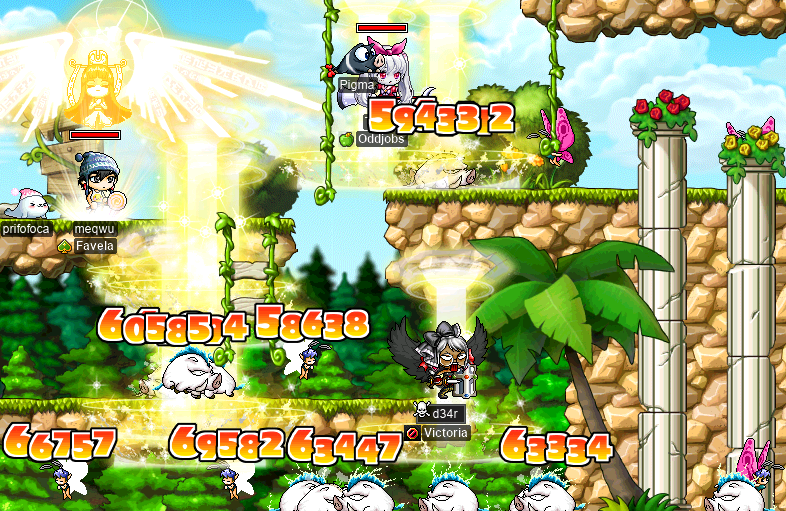
Woah, cool…! Plus, this is the side where the big pixelated fairy spawns, so I got to actually see it spawn, for once.
Oh, right. And then there’s the other half of my game: FoG. I did some FoGging with notorious STRmit Boymoder (Yunchang, Taima, Tacgnol, Girlmoder) whilst we were both on GM buffs, to some very pleasing results:
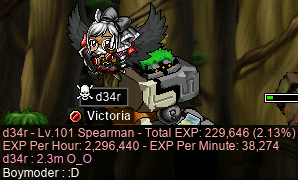
Transcription of the chatlog in the above image
[system message]: d34r — Lv.101 Spearman — Total EXP: 229,646 (2.13%)
EXP Per Hour: 2,296,440 — EXP Per Minute: 38,274
d34r: 2.3m O_O
Boymoder: :D
So would you believe me if I told you that I hit level 102(!) whilst farming Lip Lock Keys with MiIf (GiIf, Dakota) and Boymoder…?:

Footnotes for “Dee thirty-four are”
-
[↑] In my personal experience, ⟨appo⟩ appears to be a very popular rendering of English apple /ˈæp.(ə)l/, particularly in the context of Onyx Apples. As far as I can tell, this is an instance of /l/-vocalisation, where the spelling is intended to reflect something like [ˈæpo].
In English, this particular kind of /l/-vocalisation (viz. /-l/ > [-o]) is commonly associated with the Bristol dialect and with Cockney. It is, however, by no means restricted to these dialects, & /l/-vocalisation in general is found in languages other than English. One particularly humorous example is the name Bristol /ˈbɹɪ.st(ə)l/ itself: the original form is Brigstow (from OldE bryċġ “bridge” + stōw “place”), and the modern -l form is from the hypercorrection of an apparent — but actually fictitious — /l/-vocalisation.
A 2007 paper by Wyn Johnson & David Britain (“L-vocalisation as a natural phenomenon: explorations in sociophonology”; Lang. Sci. vol. 29;
doi:10.1016/j.langsci.2006.12.022) identifies several phonological constraints that promote, or hinder, /l/-vocalisation:- A velarised [ɫ] makes /l/-vocalisation possible. Moreover, [ɫ] develops particularly when the /l/ is in the coda.
- When the vowel that forms the nucleus of the rime that contains the /l/ is longer, /l/-vocalisation is more likely.
- If the /l/ is syllabic, then /l/-vocalisation is less likely when the immediately preceding consonant is coronal.
- If the /l/ is immediately followed by a vowel — that is, generally, in the following syllable, & typically in the next word entirely, as in e.g. trouble is — then vocalisation is less likely, & if it does occur, it can sometimes be accompanied by a “linking” glide /l/ or /w/.
These constraints would suggest that, assuming that apple isn’t immediately followed by a word that begins with a vowel, its /l/ is a prime candidate for being vocalised. Because the /l/ is word-final, it would easily be [ɫ] in basically any variety of English that has [ɫ] at all, which is most of them — notably excluding those of South Wales & those of Ireland. Moreover, the [ɫ] is syllabic [ɫ̩] in varieties that have syllabic consonants, & the preceding consonant is indeed not coronal: it’s bilabial /p/.
In all accounts that I can find, vocalised /l/ is described as [o], [ʊ], [u], and/or [w]. Because [w] is the semivocalic equivalent of [u] — or, in English, arguably of [ʊ] — this means that [ɫ] is apparently associated only with (near-)back vowels that are somewhere between close & close-mid. I didn’t find any descriptions to this effect, but the way that I personally like to think of it theoretically is like this: [ɫ] naturally delateralises to [ɰ] (actually [ɹˠ], except that would be identified with /ɹ/). Because English lacks /ɰ/ — and indeed, rounds all vowels in the previously-described range of tongue positions, & thus lacks the vocalic equivalent /ɯ/ (or even /ɤ/, for that matter) — the speaker is forced to round the (semi)vowel to [o〜ʊ〜u] or [w]. /l/-vocalisation, then, can be thought of as a special kind of delateralisation…?
-
[↑] No, you cannot fail the PQ in this way. If all members of the party, excepting one, are locked to a given side, then the remaining member is automatically locked to the other side.
Ironclad lad
In previous entries of this diary, I’ve mentioned — & occasionally spoken at length about — the lronman guild: the youngest member of the Suboptimal alliance. If you’re not already familiar, you should at least know the basic idea of ironman gameplay styles: never partying with other PCs, & also never trading with — nor receiving items/mesos from — other PCs.
These are some pretty hefty restrictions that remove a handful of the game’s core mechanics, so as to force absolute self-reliance onto the player. As a result, it’s even more impressive to see iron characters achieve great heights, not the least of which being guild leader Jonathan (Gumby, daggerknight, Edward, Kimberly) hitting the big 120!!:
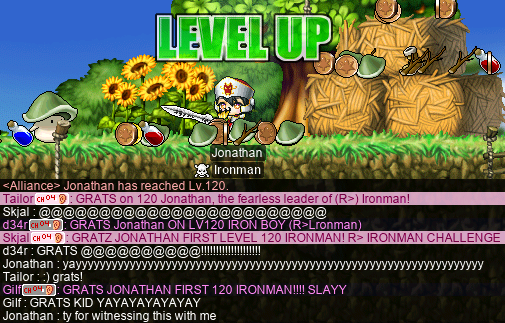
Transcription of the chatlog in the above image
[system message]: ⟨Alliance⟩ Jonathan has reached Lv.120.
Tailor [smega]: GRATS on 120 Jonathan, the fearless leader of (R>) lronman!
Skjal: @@@@@@@@@@@@@@@@@@@@@@@@@@@
d34r [smega]: GRATS Jonathan ON LV120 IRON BOY (R>Lronman)
Skjal [smega]: GRATZ JONATHAN FIRST LEVEL 120 IRONMAN! R> IRONMAN CHALLENGE
d34r: GRATS @@@@@@@@@@!!!!!!!!!!!!!!!!!!!!!!
Jonathan: yayyyyyyyyyyyyyyyyyyyyyyyyyyyyyyyyyyyyyyyyyyyyyyyyyyyyyyyyyyyyyyyyy
Tailor: :) grats!
GiIf [smega]: GRATS JONATHAN FIRST 120 IRONMAN!!!! SLAYY
GiIf: GRATS KID YAYAYAYAYAYAY
Jonathan: ty for witnessing this with me
Woah!! That’s the first level ≥120 ironclad folk on this whole server!!!
Now achieving the honourable rank of hero, it was time for Jonathan to learn a whole host of new shiny skillz. For Rush in particular, its questline requires the warrior to join another 4th-job warrior in a party of two, in order to enter a special map with special Taurospears. This part of the questline is otherwise simple: kill 200 of ’em.
Perhaps you… see the problem here. Does that mean that iron warriors can’t ever get the Rush skill? At its most simplistic, the answer is “yes”. But as long as Jonathan is doing absolutely 100% of the work, a slight exception seems warranted:

On my darksterity knight rusa, I was happy to fill the role of “another 4th-job warrior”.
We found out that, once we were teleported into the Secret Shrine, I could immediately leave (back to Sanctuary Entrance III) without kicking Jonathan out of the map with me. So I wasn’t even present for any of it! I do, however, bring to you a rare & hitherto unknown creature: party chat with Jonathan.

Transcription of the above image
Jonathan [party chat]: wow
nice
ty hehe
rusa [party chat]: :P
np!
Jonathan [party chat]: unless
u want me to leech u
rusa [party chat]: LOOL
rare jonathan pink chat
😉
A world t00r with d00r
My dear reader, I regret to inform you that there will be no new episode of The Adventures Of GiIf & d00r™ in this here diary entry. I do, however, have something of a substitute: A World t00r With d00r™[1]! ✨Wow!✨
I took my clericlet d00r around a tour of the Maple World’s cemeteries, graveyards, burial grounds, & necropoleis, Healing to re-death anything that I could find. I didn’t take screenshots of every map that I ground[2] in, but I did level up a few times in the process:
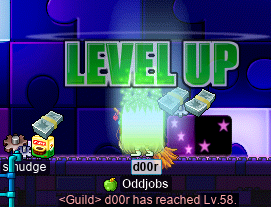
Okay, we saw the Lost Time ⟨2⟩ stuff last time. Let’s move on…

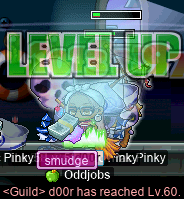
It was here at Singapore’s “Ghost Ship” that I accidentally stumbled upon a rare sort of beast: the Hexashad.
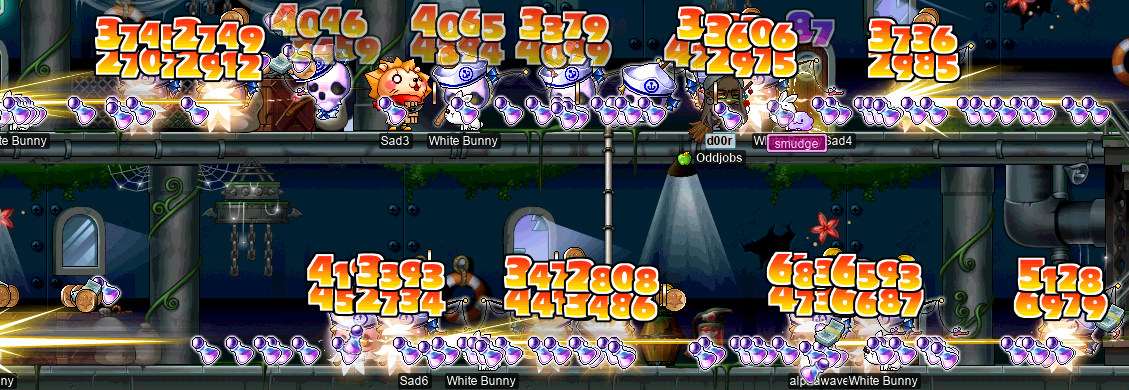
Isn’t Nature just beautiful? Anyway…
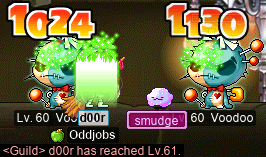

Wow, level 62 already? I’ve only just finished my t00r! In any event, here are the results:
| map | species | kEPH |
|---|---|---|
| Dead Mine II | Miner Zombie, Flyeye | 612 |
| The Path of Time ⟨1⟩ | Platoon Chronos | 728 |
| Lost Time ⟨2⟩ | Master Chronos | 738 |
| Remains ⟨Tomb⟩ I | Skeledog, Mummydog | 759 |
| Cemetery Full of Ghosts | Coolie Zombie, Nightghost | 941 |
| Camp 2 | Skeleton Soldier, Officer Skeleton | 946 |
| Ghost Ship 6 | Mr. Anchor | 982 |
| Camp 1 | Skeleton Soldier, Officer Skeleton | 1 094 |
| Line 1 ⟨Area 4⟩ | Wraith[3] | 1 138 |
| Ghost ship 1 | Pac Pinky | 1 166 |
| Ghost Ship 5 | Selkie Jr. | 1 223 |
| Sophilia’s Bedroom | Voodoo | 1 245 |
| Mysterious Path 3 | Selkie Jr., Slimy | 1 306 |
| Forest of Dead Trees III | Coolie Zombie[3] | 1 411 |
| Ghost Ship 2 | Slimy | 1 471 |
Of course, there are the obligatory ⚠️caveats⚠️:
- I only did two
@epm 8tests per map, & then took the midpoint of the two results. - I levelled up a few (viz. four) times during or in between tests, potentially making my damage output somewhat uneven across different maps.
- These EPH values have little chance of being representative, unless you happen to be a level 55〜65-ish clericlet (or something vaguely equivalent). If you only care about relative values (comparing maps to one another), then these values might(?) nevertheless be useful, but should still be used with great caution.
You might wonder why I tested some of these maps, or why I didn’t test some other maps:
- Dead Mine II is notable for being probably the best map for farming Zombie’s Lost Gold Teeth.
- I did not test Lost Time ⟨1⟩ because I didn’t think it worthwhile to test Platoon Chronoses twice.
- Remains ⟨Tomb⟩ I is an atypical grinding map, but nevertheless occupies a somewhat important position in Vicloc.
- Cemetery Full of Ghosts allows for farming some Nightghosts for their interesting droptable (not the least item of which is Triangular Bandana of the Nightghost, for Faito’s exchange “quest”), but without the severe downside of A Desolate Cemetery having a significant population of non-undeads (viz. Big Cloud Foxes).
- Camp 3’s map layout felt like it would be too hostile to the Heal skill.
- B3 ⟨Subway Depot⟩ is probably worth testing, but L1A4 is at least as dense, has way more spawns, doesn’t have Jr. Boogies, and freely allows for 140% SPEED & the use of my level 20 Teleport skill.
With all that being said, there are a couple of interesting things that I noted about these results:
-
The Dead Mine II tests were proof enough that any significant population of non-undeads pretty much instantly obliterates my EPH.
-
Training on Chronoses of various kinds is actually not so great EPH-wise. Of course, the Master ones do still drop those joocy helm DEX 60%s…
-
Cemetery Full of Ghosts has decent EPH, pretty dang good drops (even with the Coolies diluting the drops somewhat), & is geographically accessible from anywhere that has a Spinel. Kind of a great all-around trade-off map…?
-
Even in spite of the incredible fact that Heal hits both platforms at once(!!!) in GS6, it performs rather underwhelmingly, especially when compared to the other Singapore maps. Mr. Anchors also have a nearly worthless droptable.
The saving graces here are that it can be ground very effectively with little effort (you need only the tip of your nose to hold the Heal button…), plus the fact that my damage is kinda pp pupu. If your damage is way better than mine, then GS6 will look relatively… less bad.
-
Our Victorian locations here are, perhaps surprisingly, reasonably competitive overall. And here, Wraiths reign supreme, despite being ≈12 levels lower than the Camp species.
-
Voodoos are wildly high EPH, considering the minuscule size of their map. Plus, gotta get those Heartstoppers & wand 60%s…
-
Even without access to Singapore nor Masteria, the (Old) Ossyrian (e.g. an OSS-locker) is quite spoilt here. Although FoDTIII does lag behind GS2 in my tests, it does so only barely, & certainly makes up for it with the Coolies’ more useful droptable.
-
Wow, GS2 came out on top EPH-wise. Literally no one saw that shit coming. Someone stop the presses.
More seriously, MapleLegends did “nerf” GS2, but this only consisted in making the Slimys’ ranged attacks reach far enough to hit anyone standing on the stairs, so that attackers can’t just stand there all day and hold the Heal (or whatever AoE skill) button. When I’m grinding, though, I’m not AFK, so this has no significant impact on my EPH.
Given these results, you might’ve expected d00r to make GS2, or perhaps Sophilia’s Bedroom, her new home. But no! I like freezing my bum off!! And collecting teeth!!! Like a lot of teeth!!!! So I made FoDTIII my new home. 😊
When d00r hit level 64, I decided to spoil the brat even more by buying her a scrolled Maple Wisdom Staff with a healthy 104 TMA!:

Transcription of the above image
Maple Wisdom Staff (+6)
- Req lev: 64
- Req class: magician
- Category: staff
- Attack speed: normal [6]
- INT: +8
- HP: +155
- MP: +53
- Weapon attack: 52
- Magic attack: 96
- Number of upgrades available: 0
& o, I do b grindin’. Especially to farm those pesky baking Etcs for the Thanxgiving event (see the “Our palms to the light” section below)!
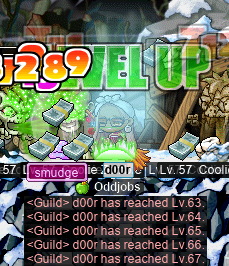
O boi. 67? I think we might be seeing a certain new priestlet on the block in the next entry…
Footnotes for “A world t00r with d00r”
- [↑] My apologies if you prefer /tʊə̯(ɹ), tuɹ/ (no cure–north merger) or /tɝ/ (cure–nurse merger) for tour. Dewar 🚪, anyone…?
- [↑] Grinded??
- [↑] Shade & Riche do not count.
ˈʁuzə
But I think it’s time for some MapleStory Game Content™ that’s a wee bit different from d00r determinedly Healing directly at horde after horde of zombies. How about my darksterity knight rusa determinedly Crushering directly at boss after boss…?
I did yet more Namie duoing alongside marksman xBowtjuhNL (PriestjuhNL, BuccjuhNL) — but now, I’m able to use my pugilist tarandus as a glorified SI mule! Wow…!
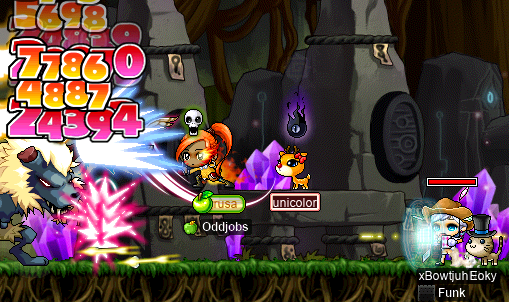
Not pictured: tara clinging to the rope above us for dear life.
I also signed up for a pair of Horn’d Tail runs hosted by Lj (Davina, Abella). I offered to run as sed target, but when the time came around, our sed bishop Verdict (Hui, Viewty) had fallen rather a bit ill, & wasn’t feeling up to the task of being a proper sed bish. As a result, I ended up running as an ordinary attacker instead, with the sed target role filled by her sed mule.
Lj must have had some pretty bad experiences with goofy HT runners goofin’ around a li’l too much with those goofy HT arms, because they were very serious about absolutely no one touching the damnable things. Now, normally, I would just attack the left & mid heads during the first part of the main body fight, when most attackers are taking down the legs & tail. Attacking on the floor is quite awkward for most melee attackers, & plus, I can get in a bit of cheeky cleave action if neither of the two heads are weapon-cancelled. But Lj seemed adamant that everyone be attacking in the same way, so… I tried my best:

Attacking legs is bad enough — especially because I’m tryna Zerk out here — but when it came to the tail, I really had very little idea of what I was doing. It’s virtually impossible to tell whether I’m actually hitting the thing, & because I’m Zerking, getting a little too close is enough to instantaneously obliterate ya girl rusa.
During the first run, Hui’s sed target client crashed partway through the main body fight, so I ended up being sed target for a bit anyway…:

And, during the second run, I tried my luck on a sneaky li’l @dpm 40 test, armed with a HT buff, Echo, MW20, & SI:

Transcription of the chatlog in the above image
[system message]: rusa — Lv.184 Dark Knight — Total Damage: 70,664,669
Damage Per Hour: 105,996,960 — Damage Per Minute: 1,766,616
That’s about ≈1.77M DPM over the course of 40 minutes, for those of you following along at home. I do like seeing the results of these long-form tests that give a good idea of sustained DPM over the course of a fight; but at the same time, they feel a bit painful to do, & at the end, I always feel like I really could have done better (still looking for that ≥2M reading sans apple(s)…). Plus, with something like HT, the results are subject to a good amount of straight-up randomness.
In any case, I did even more DPM tests later on — but this time, over in Neo Tōkyō! I did a pair of Nibelungs alongside shadower Harlez (Gock, Murhata, VigiI), & buggin’ years Camylla & notnotgroovy (groovyfeet):
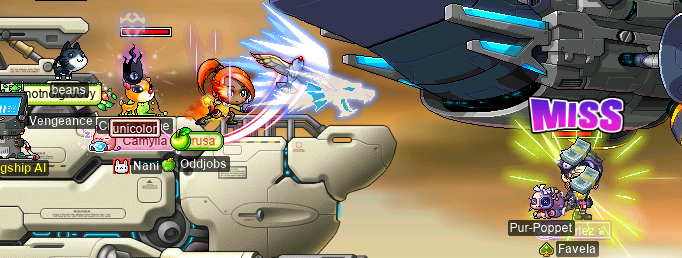
Not pictured: both Camylla & notnotgroovy, both mid-Demo.
And in a pair of NMM runs with Bohm aster Bowchi, I tried my hand at a @dpm 10 test:
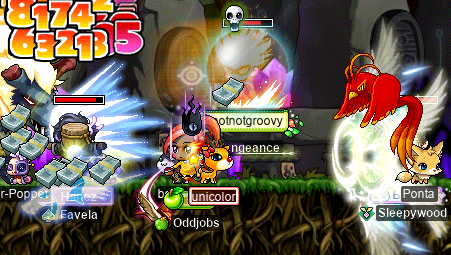
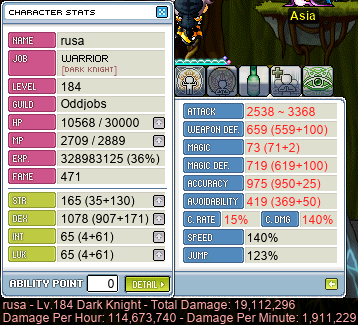
Transcription of the chatlog in the above image
[system message]: rusa — Lv.184 Dark Knight — Total Damage: 19,112,296
Damage Per Hour: 114,673,740 — Damage Per Minute: 1,911,229
Well, gee. NMM is only one (1) target, & yet, here I’m still doing even better than that @dpm 40 in HT…
Oh, & we can’t forget those weekly PB runs! Like this one, where I got a cool(??) bug that made me permanently Poison’d for the entire duration of the main body fight, & even after leaving the Temple of Time entirely…:

Transcription of the chatlog in the above image
[system message]: The mysterious skills of an old halfling have transformed you into a dragon. You can now fly.
You’ve been poisoned, so your HP will slowly decrease.
Right, so, normally, when in flight to the Temple of Time or back to Minar Forest, you’re stuck in an uncancellable transformation that makes you look like a cute little red dragone. As it turns out, however, this transformation isn’t so uncancellable if you just take damage! Like from Poison that just won’t go away!!
Before one of my PB runs, I was consulted for advice by a level 200 DK by the name of ScrambleEgg, who had never run PB before. It is, in a way, a bit strange to be approached like this by someone who is effectively more than twice your level[1], & I don’t exactly feel like a hardened PB veteran myself, so this marked the first time when I got to feel like the experienced one! I gave my best advice, for which ScrambleEgg was grateful. But then, disaster struck… only a few minutes into the main body fight. My power went out! What the fucc!! 🤬
Obviously, this was a big disappointment for me, but my immediate concern was that this would end up being an “out of the frying pan into the fire” situation for ScrambleEgg: now that I was gone, some people were left mysteriously lacking a source of HB, meaning that someone would be doing some party-swapping…! The humour of it was that, when she whispered me after the PB run cleared, she said that she thought that the party-swapping was just normal, & only realised afterwards that it was a result of my having d/ced… Well, I suppose it was an instructive first run for her. 😅
I also signed for my very first HT hosted by Qub* (Qubsanity, Qubert, Qubbler, Qubtain), on behalf of the Dream alliance. It was here that I decided to just test my DPM against the preheads…:
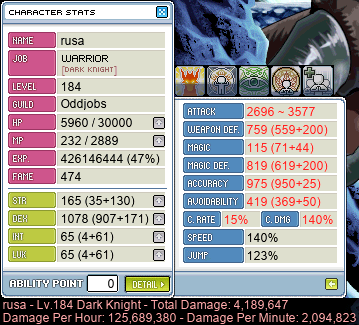
Transcription of the chatlog in the above image
[system message]: rusa — Lv.184 Dark Knight — Total Damage: 4,189,647
Damage Per Hour: 125,689,380 — Damage Per Minute: 2,094,823
Well, gee whizz. 2.1M whole DPM on this one li’l head? I’m telling you, cleaving heads from the right-hand side of the main body map is just too difficult! Sub-pixel precision AAAAAAAAAAAAAAAAAAAAAAAAAAAAAAAAAAAA
Ahem. Like I was saying, I signed up for this Dream HT especially quickly, because they were in need of some HB for bow mass stirs xRook (misandrist) & Flai (Wavedashing, Backshot, FIai, Flaislander). But once the time to run came around, xRook had switched to their bishop misandrist, & Flai couldn’t make it. So I was just kinda chilling & giving HB to people who didn’t super need it…

…But it was very fun. 😎
Footnotes for /ˈʁuzə/
- [↑] Recall that level 187 is the halfway point between level 1 & level 200, EXP-wise.
The Maple World is under attack!
Speaking of HTing with Qub*, the scheduling of that pair of HT runs turned out to be unfortunately aligned with the timing of a certain very special GM event.

Transcription of the above image
Abagnale [GM announcement]: Maplers, I hope you are having a fantastic day.
However, the Maple World is in danger.
[game-wide notice]: (Rina) Help!
Hello, this is Rina from Henesys. There are monsters attempting to invade Henesys and I need your help to defeat the monsters!
Oh shit!! Oh my god, Rina!!! Luckily, I was already chilling at Henesys on my Vicloc dagger spearwoman d34r, so I rushed to Rina’s side:
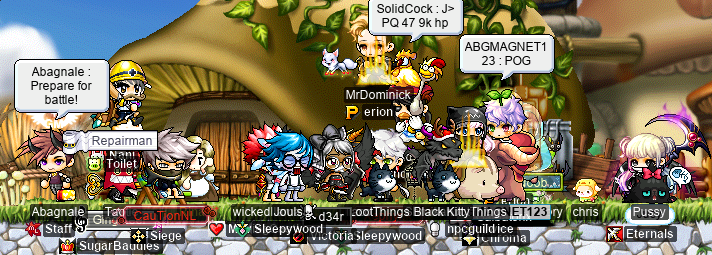
Maplers began to pile up in Henesys from all over the Maple World, & after only some minutes, monsters began to spill into the town of Henesys in numbers too vast to even comprehend:

What even are they? Giant black cats?? I certainly can’t tell, considering I’m well below 1 FPS!!!
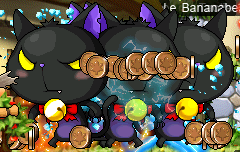
As it turns out, these are actually Cursed Black Cats. They’re level 35 boss monsters from GMS’s 2009 Hallowe’en event (v77).
Once the Cursed Black Cats were banished, however, peace was not yet restored in Henesys. Because… Giant Tomato.

As far as I know, this particular monstrous nightshade never existed in GMS. Instead, it was an EMS speciality, used for hosting La Tomatina events. The MapleStory version of La Tomatina is kinda like what you see above: giant tomatoes spawned in major towns. I even found a screenshot of one of the originals in EMS:

However, the original EMS event was a bit more extensive, featuring its own set of party-oriented event quests: Ben’s tomato farm 1 & 2, as seen in the above image. Later on, in 2011, MapleSEA would get its own version of the La Tomatina event.
In real life, La Tomatina is a Valencian festival held every year in late August, where people basically just throw a shit ton (like a shit ton) of tomatoes at each other.
In any event, once La Tomatina was over, it seemed for a moment like we’d saved Henesys & the Maple World from monster invasion. But then, there was another cry for help, from Lisa of Orbis! Oh no!!

Unfortunately, I had to switch to my pugilist tarandus for this one, since d34r is not under the collective illusion that so-called “Ossyria” (🙄) is a real place that you can go to.
But would it be a real ride from Ellinia to Orbis if there weren’t a sudden invasion of two hundred Crogs…?:

Once we had a handful of deaths — presumably due to sheer shock — the rest of us landed safely at Orbis, & rushed to Lisa’s aid:
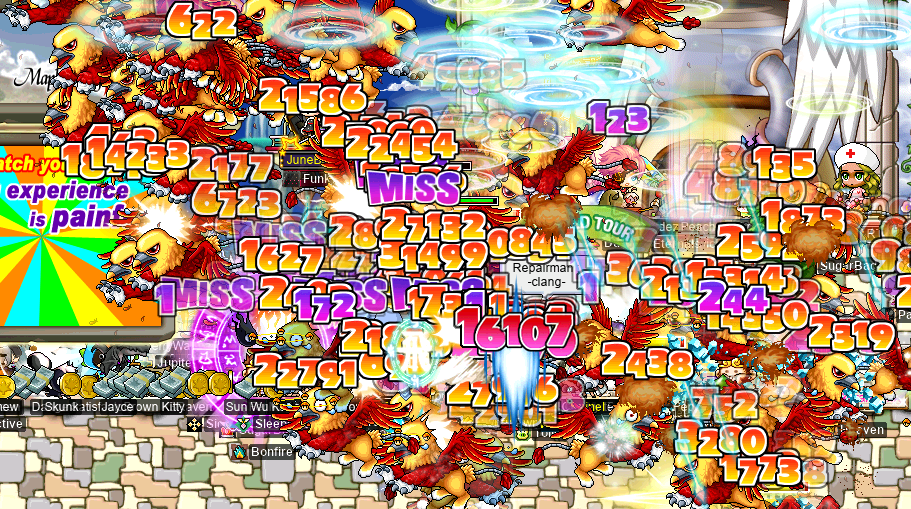
Gryphons? In my Orbis?? I don’t think so…

Goated.
Unfortunately, by the time that we’d defended Orbis from Gryphons, Goats, Commander Skeletons, & probably at least one or two other things that I can’t remember, I already needed to start heading to the Peak of the Big Nest for those HT runs. I do, however, have just one more screenshot of this event for you, courtesy of Taima (Yunchang, Boymoder, Tacgnol, Girlmoder, Hanyou, deerhunter):
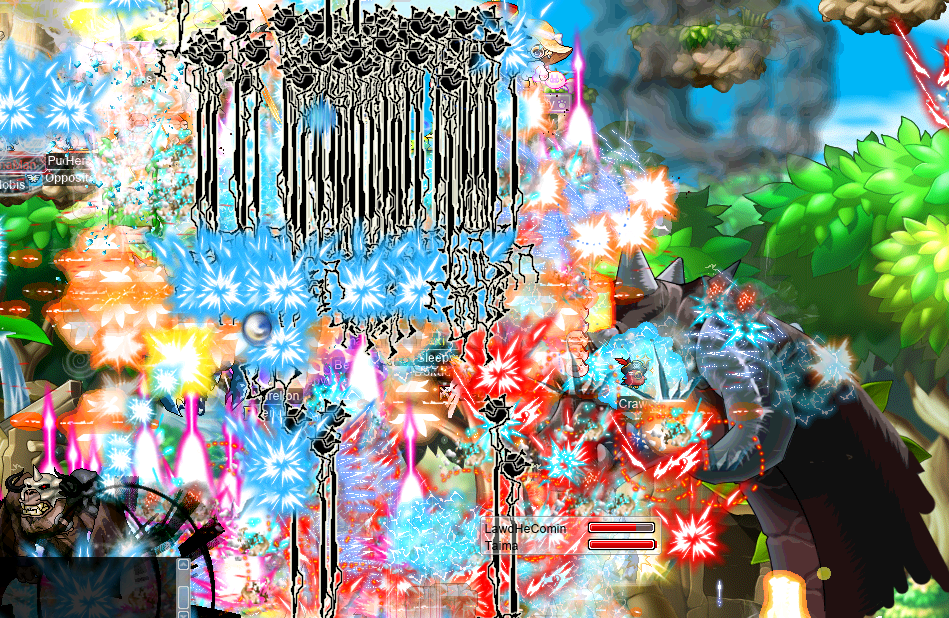
This is just a zillion Crogs & one awkwardly-positioned HT head, spawned somewhere in the town of Leafre. You can even see the brush strokes on the lower end of the HT head’s neck, since that part isn’t usually supposed to be visible! I heard of HT fighting, a zillion BFs, and even an Aufheben & a PB fight in this crazy GM event. Wowza!
Although I am sad that I only got to attend the first two parts of this many-part GM event, I’m also glad to have attended any of it. It’s a bit of fun, & I think that part of what makes it cool is that it’s an extremely rare event. Plus, there really is something exciting about a genuine invasion of parts of the Maple World that we usually think of as being 100% monster-free!
Moose xing
Oh yeah, baby! It’s time to do some more card-hunting with your host, stabby stablord McDaggerface alces! In the previous episode (see the “Bats spelled backwards is stab” section of the previous entry in this diary), I stopped at the I.AM.ROBOTs of the Masterian Mountain Slopes. This time, I painstakingly finished up that set, & then moved on to even more hellish territory, by going up to the Mountain Cliffs to hunt the Gryphon set.
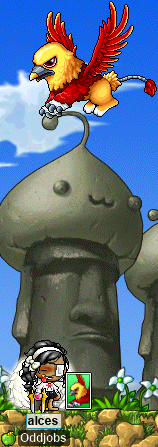
Oh boy. As you can likely imagine, being stuck largely with some combination of Double Stab & Taunt isn’t exactly ideal when it comes to hunting these airborne crimson bastards. Nonetheless, although they were quite stingy with the cards at first, they eventually relented, and I finished this set after much pain & suffering.
As a result, I’d now finished all the Krakian Jungle card sets. The next area of Masteria that I tackled was the interior & underground of Bigger Ben: MesoGears. In the Deity Room, I got the Fire Tusk set…:
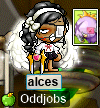
…And the Killa Bee set:
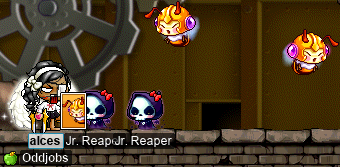
And yes, that does mean more flying monsters to kill. Le sigh. But it’s not quite so bad here: the map layout is significantly less hostile than those of the mountainous regions of Krakia (which is not saying much LOL), & spawns are generally denser, with most of them occupied by ground-dwellers.
I had a bit of a dumb shower thought as I was jumping around the Deity Room, endeavouring to smacc these flying cyborg insects variously with Double Stab & with Taunt. Because Double Stab is a melee attack with unimpressive reach, we can think of it as targeting a single point in space. On the other hand, Taunt is basically a ranged attack with a projectile that always travels horizontally (like IA, but unlike AB), thus making its corresponding target more like a horizontal line segment.
My tiny monke brain latched onto the fact that points & line segments are species of differing dimension: zero-dimensional & one-dimensional, respectively. This implies that the space that the line segment virtually lies within — viz. a line — has fewer translational degrees of freedom (TDOF) w.r.t. how it’s embedded into the game-physical 2D space than the point does. This is because the TDOF within the space is subtracted from the TDOF of the space that it’s embedded into: TDOF for the point, defined as it is by two coördinates ; TDOF for the line, as it’s infinite in one of the two directions, & can therefore be defined — given its angle of orientation — by a single coördinate; and TDOF for the plane, because there is only one plane (again ignoring orientation)!
Why do I care? Well, first of all, because peanut brain, as previously discussed. But also, given that each Killa Bee has a hitbox (usually an AABB, but for all we care, it could probably be an arbitrary polygon or whatever) associated with it, we can say that my attack “connects” with the Killa Bee iff the intersection between the set of points that my attack targets & the set of points contained in the Killa Bee’s hitbox is not empty (read: the sets are not disjoint). Then, the fact that the line has fewer TDOF is relevant to me: it means that Taunt is generally easier to target the Killa Bees with, because I only really care about the 𝑦-value (height) at which I make the attack. Compared to the two TDOF with which I have to position my Double Stab attacks, Taunt is then — in a limited sense(!) — “easier to target” than Double Stab by the same amount that a quadratic function grows quicker than a linear one does.
Well, in any case, I had already gotten my Electrophant set on the Mountain Slopes, & Wolf Spiders can suck my entire ass, so I was already done with MesoGears. That meant that it was time for none other than the Phantom Forest’s very own Haunted House!
In the “The mystery of the Prendergast Mansion” section of the previous entry in this diary, I did the Haunted House quests for the very first time, on my pugilist tarandus. Now that I was hunting the Haunted House sets on alces anyway, I decided to do the quests on alces as well! To gather some Firewood & to complete “Nightmare”, I did — you guessed it — the Nightmare set:

To retrieve Ludmilla’s fancy earrings, & to complete “Sophilia Doll”, I did the easiest card set in the game: the Sophilia Doll set.

To get some Loaded Springs for “The Infernal Toy Machine”, & to complete “Psycho Jack”, I did the Psycho Jack set:
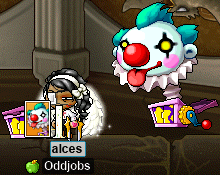
It might not be a card set, but you better believe I also got that Toymaker set:
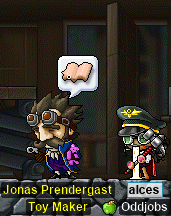
And of course, for Agent Falcon’s quests — & perhaps more importantly, “Eat This!” — I farmed many a Glutton Ghoul…:

…By which I mean very many Glutton Ghouls. Not only is “Eat This!” kind of a pain in the bum, but worse still is just getting the goddamn Glutton Ghoul set!:

Not only did I have to deal with yet more fly guys, but by the time I was 5⧸5 on this one, I had collected a total of 195(!) Gummy Slimes of the 80 necessary to complete “Eat This!”:

Transcription of the above image
Eat This!
- Red Gummy Slime 48/20
- Green Gummy Slime 39/20
- Purple Gummy Slime 44/20
- Orange Gummy Slime 64/20
Of course, not all the species of the Haunted House are involved in its quests. I also had to complete the Hoodoo…:

…And Voodoo sets…:

…Which have less than stellar droprates given how few spawns there are, but it’s not terrible.
And with that, the Haunted House is done. Finished. Completed. Perfected. So it’s time to wander further out into the Phantom Forest, starting with the Leprechaun set at Swamp Bog:

Swamp Bog, & many other Phantom Forest maps, also has Phantom Trees. The Phantom Tree set kinda completes itself, though.
As I ventured further into the bowels of Masteria, I realised something truly shocking: I never actually did all the Masteria quests on alces! In fact, if you can even believe it, I didn’t do Elpam Gorlab’s questline: “Lost!” & “ReVersal”!! So I decided to just get those out of the way right now, especially because this questline is a prerequisite for “Finding Jack” & everything that follows. Plus, I figure I can also do Clock Tower Monster Wipe-Out whilst I’m around that region for the purpose of completing “ReVersal”.
So, for “Lost!”, I hunted for Elpam Magnets from the Barnard Grays of the Kulan Field:

And yes, that is where we’re abruptly cutting short this episode of alcestory™, because in MapleLegends, event plays you!
Our palms to the light
Gather ’round, one & all, to see the master of the brawl: it’s time for some Questin’ With tara™, starring your host, tarandus the pugilist (that means I use my hands & feet to punch & kick the bad guys)! She might not be a brawler anymore, but for some reason, I still think of her as a little snot-nosed brat, even though she’s like, level three thousand or something now.
Does Super Transformation’s “mastery +5%” apply when unarmed?
But first, we must ask the age-old question that has troubled pugilists for decades — nay, centuries: does level ≥11 Super Transformation actually give +5% mastery? After all, it says as much right in the description:
MP −60; weapon & magic def. +60 & mastery +5%, waiting time until next use : 180 sec.
Regrettably, however, like the vast majority of skills in MapleStory, ST fails to actually tell the user what it even does. Thus, knowledge of even the most basic of MapleStory’s game mechanics lies within the realm of the occult, largely unknown even to those deeply affected by it — where even those areas which have been illuminated are done so only dimly, passed down from generation to generation in vagaries, half-lies, half-truths, riddles, omissions, oversimplifications, & even outright falsehoods, all so frequently spoken with the unthinking confidence of so many adages.
The lies & the half-lies, of course, start with the game itself: the skill promises an addition of five percentage points of mastery, & unlike the Knuckler Mastery skill, notably pledges no oaths of affinity with any particular weapon type. Here’s the description of the Knuckler Mastery skill, for comparison:
Boosts the accuracy and the mastery of Knucklers. This skill only applies when you equip a Knuckler.
And, at max level (20), its level description reads:
Knuckler Mastery 60%, Accuracy +20.
The first mystery is actually a bit simpler: does ST’s bonus to mastery only apply when the buccaneer is actively Super-Transformed? The question is parallel to that of Beholder, which is also an active skill that promises additional mastery. As it turns out, in pre-BB MapleStory (& maybe also in post-BB MapleStory — I’m not sure), there is no such thing as a buff that increases mastery. As a result, mastery increases are necessarily passive boons, and so only directly depend on skill level (& possibly also on the weapon/attack being used to attack, of course).
Indeed, by doing some testing between my darksterity knight rusa & fellow odd-jobbed DK daggerknight (Jonathan, Gumby, Edward, Kimberly, j0hnny) the dagger DK, I found out some time ago that the mastery increase from Beholder satisfies all the following properties:
- It’s passive, as we’ve seen.
- It only applies when wielding a spear or a polearm.
- It’s correctly reflected in the damage range (“Attack”) displayed in the “Detail” subwindow of the “Character stats” window.
The second of the above three properties does not give us much hope when it comes to ST’s mastery bonus applying to anything other than a knuckler-wielding PC. Nonetheless, the third of the above properties gives us one relatively convenient way to put ST to the test.
I ensured that tara had equipped some reasonably representative gear, ensured that she was entirely unbuffed, & then took a look at that raw damage range as displayed in-game. Her relevant total stats (not including the implicit +31 WAtk from being unarmed) were as follows:
- STR: 877.
- DEX: 105.
- WAtk: 50.
The in-game raw damage range then reads:
353 〜 3068
Plugging these exact same stats into my damage calculator on the Oddjobs website, the result is completely identical. Wow, no way! My damage calculator actually works? Crazy.
The problem is that my damage calculator assumes that an unarmed PC always has an effective mastery of exactly 10%, & in any case, I input the mastery as 10% as well. This means that, because tara has maxed out (level 20) ST, any hypothetical “mastery +5%” from ST either doesn’t apply when unarmed, or is incorrectly not reflected in the raw damage range listed by the “Character stats” window. Considering what we know about Beholder — another 4th-job skill, added to the game during the same era — the latter seems deeply unlikely, & the former seems very likely.
Just to be sure that I worked around any quirks that might be present, I looked at my in-game raw damage range display whilst ST’d, whilst not ST’d (& thus totally unbuffed), & also made sure to switch maps, change channels, &c..
Given that I also didn’t notice any change in the stability of my damage when I crossed the level 10 → 11 ST threshold, I think that the answer to our original question is clear: no, Super Transformation’s “mastery +5%” does not apply when unarmed (& thus, presumably, doesn’t apply when not wielding a knuckler in general). F4
A shield changes hands
In more heartening news, I got a new shield!! Although she is a shield pugilist, tara isn’t my only character who frequently uses a shield. But in any case, I had been agonising for quite a while over the reality that I was probably going to have to scroll my own Maple Shield — since before the last anniversary event[1], even.
My old shield was a 15 WAtk Stolen Fence, & I had been borrowing a 17 WAtk Maple Shield from Permanovice (Hanger, Battlesage, Dreamscapes, Aniket, illadvised) for a while. I really loathe to borrow gear, however, & my crusty old Stolen Fence wasn’t gonna cut it for me, so I set my sights on a shield with ≥18 WAtk. Problem is, this shield has to be equippable by tara at the very least, & with tara being a pirate, this implies that it must be a common (as in, no class requirements) shield. This technically leaves a variety of options like the Stolen Fence & the Maple Shield, but also the Pan Lid[2] & the Palette. Only the Maple Shield, however, has enough slots (10 > 7) to make my ≥18 WAtk goal quite reasonable — plus, it comes with a little bit of nifty AVOID!
Then, I saw that Qub* (Qubsanity, Qubert, Qubbler, Qubtain) had a shield very closely meeting my specifications, for sale right now!! They were pleased to see that someone was interested in the shield, & even more so to see their old shield pass into the hands of someone whom they knew:
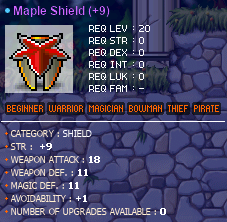
Transcription of the above image
Maple Shield (+9)
- Req lev: 20
- Category: shield
- STR: +9
- Weapon attack: 18
- Weapon def.: 11
- Magic def.: 11
- Avoidability: +1
- Number of upgrades available: 0
Very nice! Shields are over now!! Hopefully!!!
Gobble gobble, motherfuckers
This episode of Questin’ With tara™ starts with MapleLegends’s 2023 Thanksgiving event. You see, MapleLegends is based on v62 of GMS, which was released on 2008-11-12. GMS was, & is, run by Necksawn America™, which is based in the U.S., & so its notion of “Thanksgiving” is the U.S. version, which takes place in late November. This is to be contrasted with the Canadian version (Thanksgiving; Action de grâce /ak.sjɔ̃ də gʁas/), which takes place in mid-October, as well as with various other versions of the holiday that are celebrated in various other countries & towns.
Although Thanksgiving is obviously regional, & thus not observed at all — much less as a major holiday — in most places in the world, it does have some worldwide significance due to its association with Black Friday — & thus, by extension, also Cyber Monday.
In the U.S., Thanksgiving is associated with turkeys, to the point that it’s even informally called Turkey Day. Although the Thanksgiving event released with v62 was not GMS’s first Thanksgiving event, it’s notable that most GMS-v62-based MapleStory implementations — which are/were many — start out by having to deal with the Turkey Commando spawns hard-coded into the map data of some 28(!) maps across Victoria Island & Masteria. Wandering into, say, L1A1 in a vanilla v62 implementation will result in the player being greeted not only by the expected population of Bubblings, but also by a considerable population of cyborg turkeys running around aimlessly.
Because this affects many maps, & it’s one of the first problems encountered, the usual fix is to do what MapleLegends did: just add a small amount of special logic to the game server’s monster-spawning code that effectively disables spawners of MoID 9400568. This is kind of a kludge, & is the reason why you can still mysteriously see all of these monster spawns on the MapleLegends Library: they’re still in the map data!
Thanksgiving events are not exactly common in MapleLegends, so this is my first one ever! It is, however, a mini-event, so there’s not really that much going on. That being said, there is a bit of questing to be done, which is clearly a job for our favourite bare-knuckled punchy person:
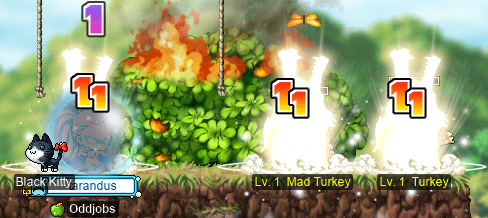
These torkeys always take 11 damage at a time — a reference to November being the 11th month of the year — and they’ve got some eggs & stuff. By farming these torkeys in their little dedicated event map for a while, I eventually got enough gold-plated eggs of various colours to get me… a chair?:
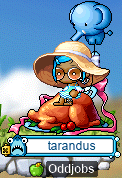
Alrighty. That marks the first, & last, time that I sit on that chair.
The other “stuff” that the torkeys drop are staples of the U.S. Thanksgiving dinner: canned Cranberry Sauce, Mashed Potato, Gravy, all that shit. This constitutes the closest thing that this event has to a “raffle”. The problem is that this “raffle” didn’t appear to be truly repeatable (I ended up getting transformation potions that turn me into a Ribbon Pig or whatever whenever I repeated it), & it only randomly awards:
- Pilgrim Hat (a capotain that is, naturally, male-only).
- Maplehontas (I am crying. Literally sobbing. Also, this is female-only! Of course!!).
- Chief Axe (actually kinda OP for its level).
Oh, right. Did I mention how Thanksgiving (in the U.S.) is actually about genocide & stuff? Oups. Holidays are probably more “fun” without the genocidey bits, but MapleLegends made sure to leave in the (arguably tasteless) reminders, which is… something, I guess.
Really, the bulk of this event is its daily quest, where you collect Etc items that drop from all monsters, in exchange for that sweet, sweet (but untradeable) Grandma’s Pumpkin Pie (not to be confused with Pumpkin Pie, which is visually identical): +80 WAtk & +150 MAtk for five minutes a pop. This provided much of the motivation for grinding on my clericlet d00r (see the “A world t00r with d00r” section above). Of course, the special-sauce-Etcs-that-drop-from-all-monsters-but-only-if-the-quest-is-active-lol only stack to one (1) per inventory slot, to ensure that we properly motivate our blessèd Maplers to “vote early & vote often” for the NX to expand those slots, & to make yet more storage mules. We love MuleStory™!
Borssing
But that’s enough of that nonsense. It’s time for some borssing. Bahzing. Bawssin’. Buzzing…?
And there’s nothing better than ボシング to remind us of how fragile Maple life is. Just one errant touch from a Banana Rāvaṇa could be the end of it all…:
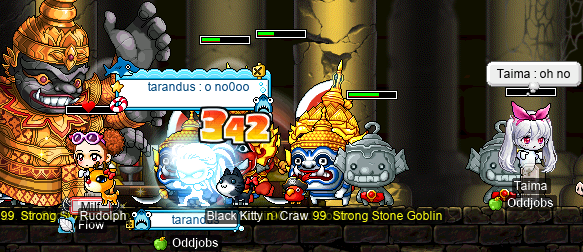
R.I.P. MiIf (GiIf, Dakota) & Taima (Yunchang, Tacgnol, Boymoder, Girlmoder). 🪦 😔
In the “Dyadic” section of the previous entry in this diary, we saw my darksterity knight rusa lay waste to the detestable scoundrel known as Dunas II: Electric Boogaloo 2nas, thus getting a 2nas clear for tara. Next in the NT2 questline, then, is laying waste to the detestable washing machine known as Corb Laze Core Blaze! I was invited to one such CBPQ run, for a clear, by shadower Harlez (Gock, VigiI, Murhata), who was duoing with bowmaster/bishop Flurri/SecretIy.
I didn’t exactly have the liberty of messing around during stage 1, because even if I brought rusa to HB myself, Royal Guard would probably still instantly one-shot me. It’s like popping a soap bubble.
Speaking of getting popped like a soap bubble, that’s exactly what I did in stage 2. I’ve previously demonstrated on multiple occasions that I’m perfectly capable of soloing this JQ stage unassisted, thanks to the technique that Danger (Hampy, Peruggia, Bonnot, Jennings, Worley) taught me. That being said, I don’t CBPQ very often, if at all, so I don’t retain very much relevant muscle memory; moreover, I was accustomed to doing this on rusa, and with all of rusa’s gear & buffs. So, even with SecretIy using her teleportation magicks to temporarily disable the entire topmost section of lasers for me, I was having trouble making it there.
Now, the lasers in this stage sting quite a bit. When I asked how much I could possibly be hit for, Harlez & Flurri gave me the figure “some 11k; you’ll be fine”. Since I had a healthy 11 555 maxHP, which — as far as I know — is greater than 11k, I wasn’t too worried about it. Unfortunately, what actually happened demonstrated the relativity of “fine”: I took 11 798 damage from a laser (yes, I clipped it) & instantly went from 100% HP to 0%. Presumably confused as to how a level 157 buccaneer could possibly have a low enough maxHP — with a good deal of HP gear, I might add — to get one-shot by a laser at 100% HP, Flurri warned me to “keep my HP up” as she Resurrected my infinitely fragile corpse.
Being obviously much more careful this time (not with my HP, but with the lasers…), I was able to make it past stage 2, & on to the final stage. The first order of business was to make sure that I dealt ≥1 damage to Core Blaze itself (“tapping” the Core Blaze), so that I would get quest credit for the kill. For that, I pretty much just walked up to Core Blaze — but not too close! — & used Dragon Strike a few times, carefully scanning the damage numbers to make sure that I was actually accomplishing what I thought I was.
Thinking that I was trying to clear the Maverick Vs & Imperial Guards, Flurri & Harlez told me to just chillax & have a go at this nuclear dishwasher…:
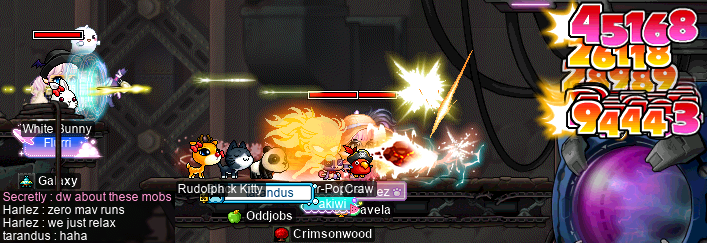
Transcription of the chatlog in the above image
SecretIy: dw about these mobs
Harlez: zero mav runs
we just relax
tarandus: haha
You can see Flurri’s Hurricane arrows in the above screenshot, but you can also see that she’s in the middle of casting a Strafe. That’s because Flurri is 2pro4me and is multi-clienting her BM & bishop at the same time, using a Strafe × 3 macro to continue attacking on one whilst she controls the other.
You can also see that I’m standing a good ways back, Demolishing Core Blaze from afar. Once my ST runs out, though, I’m a bit too afraid to get close enough to start Barraging. If my EC is up, I can ED from what’s still a reasonably generous distance, but I only ended up Barraging when I got a Smokescreen from Harlez. :P
In any case, with Core Blaze super mega ultra destroyed in a way that it could, surely, never possibly recover from, it was time to immediately do the one (1) thing that would un-destroy Core Blaze: go back in time. You know the drill: the plot of NT is some kind of timey-wimey ball; things happen, they un-happen, they re-happen, they’re erased from three or four (or three-&-a-half) universes, & Asia says a lot of stuff. Like a lot of stuff, & I’m out here getting an RSI just from skipping through her countless dialogue windows that have a per-window mean word count of like six, because this is some kind of incoherent novella serialised over five thousand MapleStory NPC chat windows.
But the point of going back in time is not to un-destroy Core Blaze. Instead, what we really want is to have a second chance at 2nas: 2.5nas. After showing 2.5nas who’s boss — again — I found that special little sparkle:
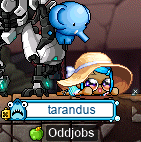
Since Core Blaze was un-destroyed, though, I’m gonna have to go back to CBPQ: the sequel: the prequel: deuxième partie: the threequel: part IV on tara. We’ll save that for another time…
But I also got to do some really fun bossing where I was A Real Participant™! Some Zaqqūming with Harlez, Taima, MiIf, Lvl1Crook (Level1Crook, xXCrookXx), & Qubert!!:

Well, the first run was a tad bit messy, & some deaths were had. But we showed up strong to that second run for sure:
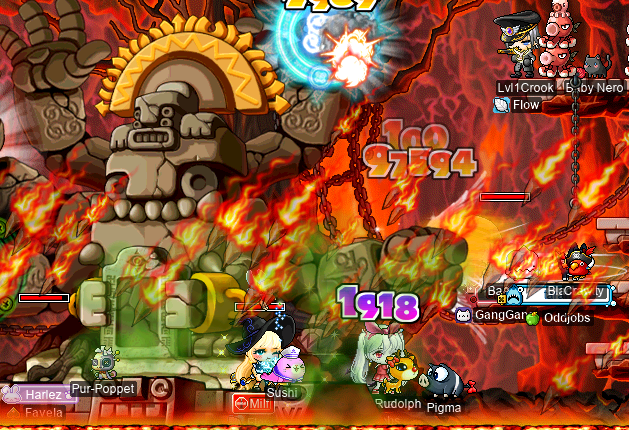
Super cool!! I mean, it’s not the fabled all-Suboptimal alliance run, & it’s definitely not the legendary all-odd run that will definitely happen I still have hope please join Oddjobs I promise it’s not a cult & it’s pretty fun I will literally fund you I’m not desperate it’s just a recommendation ok I lied I am desperate, but this was still a pair of full Zakky runs with absolutely no randos!! 🧡
And from my neck ſo free / the Albatroſs fell off, and ſank / like lead into the ſea
Kay. Buckle ur seatbelts, because it’s time for the real questing shit.
In the “Health point challenges” section of the previous entry in this diary, I did the first tier of the HP Challenges system designed by & for MapleLegends. There are currently two tiers, so… it’s time to do the other one?? Let’s go??? But first, I gave a spoiler warning last time, so here’s another one:
⚠️WARNING:⚠️ Spoilers!! Do the HP Challenges yourself first, ya goofball!!!
Full transcript
Like with tier I, I kept a full transcript of tier II. See the “Full transcript” section of the previous entry for more information about what this is.
[Challenge: Tier 2] Rosa and the Diary of Challenges transcript
The Albatross
Alright. So, I was somewhat expecting the main questline for tier II to be a continuation of the questline from tier I, as the continuation of The breaking of Arel is explicitly hinted at in-game. That is emphatically not what we get with tier II — it’s completely unrelated. But, you know, I don’t really mind either way.
This questline centres around a certain birb known simply as Albatross. Albatrosses are a fixture of English literature as a result of Samuel Taylor Coleridge’s 1798 narrative poem The Rime of the Ancyent Marinere. In this capacity, the albatross is a metaphor for a burden or curse of shame or regret, after the dead albatross that the mariner is forced to wear about his neck when a curse is placed upon the ship in retribution for his murdering the bird (with a crossbow, no less).
The Albatross of MapleLegends’s The Albatross is apparently not this metaphor. It is worth noting, however, that the setting is firmly nautical — taking place as it does entirely within the Aqua Road — much like that of The Rime of the Ancyent Marinere. Instead, though, our little Albatross is about as close to domesticated as albatrosses could ever get: they’re an inhabitant of the Aquarium’s Zoo, cared for by zookeeper Muse.
Still, Albatross is as mischievous as they are adorable, & so I found myself searching for them after they escaped the Zoo. I found them at Two Palm Trees, hanging out with good ol’ Robinson the marooned Omega Sector pilot. Robinson had even named the bird “Arby”, & they’d quickly become good friends!
Then I had to break the news that Albatross was actually Muse’s beloved friend & a resident of the local Zoo. Ouf. Robinson was at least understanding about it, although he did ask for just one thing whilst I was there: to find his Navigator’s Charm. Although its function is perhaps clear from the name, it’s also a fancy gadget that can play a few smol games like “Necki vs. Apple”. Sounds like fun to me! Where can I play it??
Well, I found Robinson’s lost Navigator’s Charm not too far below the surface, at Sand Castle Playground:
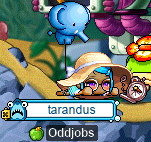
It was inside a sizeable treasure chest, which I guess must’ve fallen off Robinson’s ship…
Which, by the way, I am a fan of this little joke here, which I feel like they could have done more with:
Robinson: Oh… It’s you! Hah… hah… it feels like it’s been ages since I last saw you, but it hasn’t, has it?
tarandus: Hello, Robinson! Still no sign of your comrades?
Robinson: No, unfortunately not… I’m sure they’re working hard to get here and bring me home. But minutes feel like hours on this island. Luckily though, I have a new friend to keep me company! […]
I don’t know. Something about the idea that Robinson has been stranded here on this “desert island” (actually apparently a whale’s back, whose surface has been fashioned into something like a desert island…) for an indeterminate amount of time, wasting away; and yet, I just ✨show up✨ to do Lost in the Ocean, and then to find a missing albatross, & Robinson is still just chilling here the whole fucken time. No one else shows up. Robinson inexplicably doesn’t make use of the Omega Sector Warp Capsule that I gave him — presumably, because it just doesn’t work. Sucks to be Robinson, but at least I, personally — and absolutely no one else who might want to rescue him — can randomly make visits & then swim away whenever I want. 🤷🏽♀️ What can you do.
Anyway, Albatross does dutifully fly back to the Zoo, & Muse is quite pleased, but there’s still a problem: Albatross seems to be missing the pep in their step — or the, erm… the snap in their flap? Whatever the avian version of that idiom would be. In an attempt to cheer Albatross up & to give them something to do, I took them on a foodventure! A ✨cruiseine✨[3], if you will!
I used the Fishing Wands provided by Muse on the various aquatic monsters of the Aqua Road, capturing them one by one, like this Mask Fish at Forked Road : East Sea:
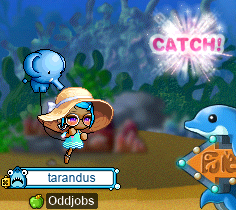
Catching monsters with the Fishing Wands yields four distinct sorts of foodstuffs that Albatross will eat, like this Colorful Fins:
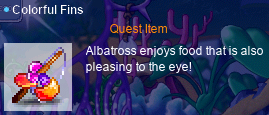
Transcription of the above image
Colorful Fins
Quest Item
Albatross enjoys food that is also pleasing to the eye!
The four foodstuffs are as follows:
- Colorful Fins results from catching Mask Fish, Flower Fish, or Bubble Fish.
- Seafood results from catching Krip, Cico, Seacle, or Pinboom.
- Poisonous Scales results from catching Poison Poopa or Krappy.
- Seal Teeth results from catching Freezer or Sparker.
Anything else — like Poopas, for instance — can’t be caught. Albatross doesn’t want that shit.
Albatross likes variety, so if fed a new foodstuff, they love it:
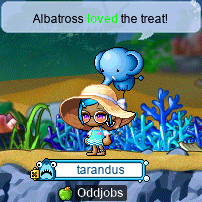
If fed something that wasn’t their immediately previous meal, but that was also eaten recently, they’ll tolerate it:
![]()
And if they’ve just eaten that kind of foodstuff, they will outright refuse to eat!:
![]()
So, ideally, the four types of foodstuff can be put in an orderly rotation:

Transcription of the above image
[system message]: You fed Albatross some Seal Teeth.
You fed Albatross some Poisonous Scales.
You fed Albatross some Colorful Fins.
You fed Albatross some Seafood.
Once Albatross has gotten enough satisfaction from their meals, they start jamming tf out:

Nice! We love a happy avian friendo!
Unfortunately, this doesn’t last long. Now that the ✨cruiseine✨ is over, Albatross is bored again. We’re starting to get the idea that perhaps an underwater zoo isn’t the appropriate habitat for an albatross — or for any bird, really. But maybe exploring the limits of the Aqua Road will show Albatross how cool it really is — there’s a lot of wacky stuff under the sea.
And by “wacky stuff”, I do mean completely invisible NPCs that you have to click on. Oh yeah, baby! We’re back at it with the Lost Coins NPCs! Like this “well”-hidden NPC at the bottom of the well connecting KFT to the Aqua Road:
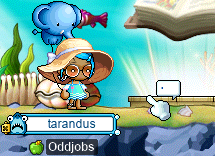
Get it? It’s well-hidden because it’s literally a well…? Anyway……
Given that there’s one of these unseeable little devils at the far-eastern outer boundary that separates the Aqua Road from KFT, then there’s probably one at its corresponding far-western outer boundary that separates the Aqua Road from the Orbis Tower; & indeed, there’s an invisible NPC in the bottom-left corner of Ocean I.C. The third & final one, then, is at a different kind of boundary: the furthest depths of the Aqua Road trench, at the entrance to Pianus’s cave.
Albatross is very pleased by these wacky adventures; but once again, as soon as the fun stops, Albatross becomes unresponsive. Muse is starting to strongly suspect that someone has cursed this poor birb! Who would do such a thing?? Well, perhaps a malevolent actor who was simply jealous of how adorable & free-spirited Albatross is, & thought that if they couldn’t have that for themself, then neither should Albatross have it.
There’s just one problem: if Albatross really has been cursed, then what exactly would we do about that? Maybe Carta would know! After all, she is a sea witch & all that…
Carta is not exactly excited to help us out, but after begging her & saying “pretty please!” a sufficient number of times, she was annoyed enough to simply pity me. She has a very special brew in mind that would cleanse the birb of any curses — if there are any to be purged. In order to brew it, she’ll need captured souls of the dead!! Before any souls can be captured, though, they need to be released from the living. For that, I killed 999 Bone Fish[4]:
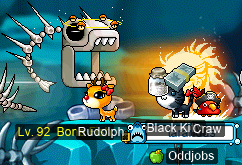
Pain… Suffering……
Plus 999 Gobies…:
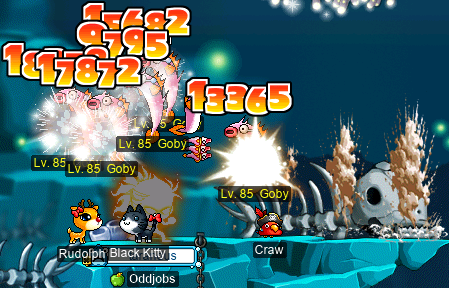
…Although by the time that I finished this quest, I had probably killed more like ≈1 999 of them…
Plus 499 each of Sharks & Cold Sharks:

Plus— Wait a sec. It seems that I accidentally hit tier 3 on my Monster Book Ring…?:
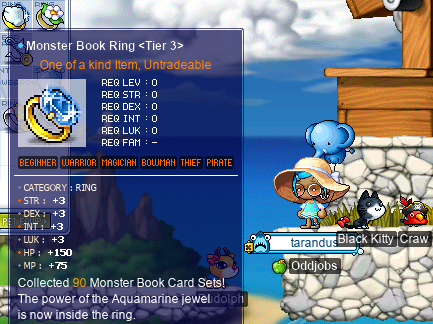
Transcription of the above image
Monster Book Ring ⟨Tier 3⟩
One of a kind Item, Untradeable
- Category: ring
- STR: +3
- DEX: +3
- INT: +3
- LUK: +3
- HP: +150
- MP: +75
Collected 90 Monster Book Card Sets! The Power of the Aquamarine jewel is now inside the ring.
Of course, tier 3 is not exactly impressive, & we’ll get tara to tier 10 eventually, but it’s worth noting that this tier 3 ring involved no card-hunting whatsoever. This is ≥90 completed card sets mostly from questing, plus a few from the handful of card-yielding grinding spots that I’ve ground at before.
Speaking of grinding spots, I did take a slight detour to 7 F with Lvl1Crook, where I hit level 158~!:
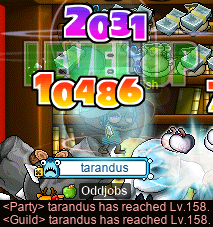
Okay, back to business. I still need 499 kills each of Squids & Risell Squids:
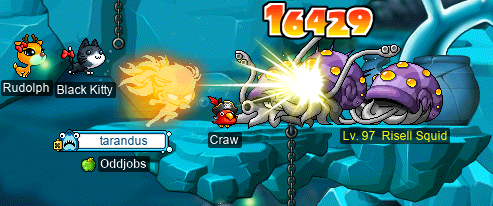
Phewf! That was quite the workout!! But now, there should be enough released souls that’ve been damned to the nightmare dimension known as Sea of the Lost Souls, & so I can… go to the nightmare dimension to capture them? Something like that.
Carta is the only one in the Maple World (aside from the villainous Pianus, who isn’t originally from the Maple World, but who was rather sent here as a punishment) who even knows that this undead underwater dimension exists, much less would anyone else know how to actually get there. So, I entrusted Carta with taking care of Albatross whilst I was away in the Sea of the Lost Souls, & allowed Carta to transport me there.
…Except that Albatross was not happy with this arrangement — not one bit! Rather than letting Albatross scream & cry because I abandoned them in the mortal realm, my only good choice was to simply take them with me. So, Albatross & I went to visit the Sea of the Lost Souls, Carta’s Fishing Wand in hand:
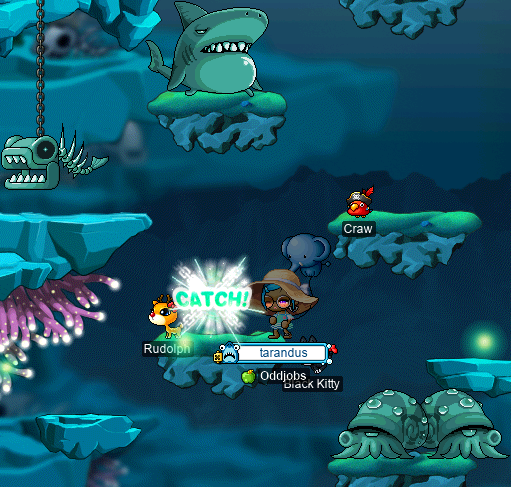
The Sea of the Lost Souls appears in many ways like the familiar trench of the Aqua Road, but its walls are impossibly narrow, & impossibly tall; looking upwards, the trench just… keeps going up, receding unboundedly out of the limits of one’s vision. And the monsters are uncanny as well: their basic shapes & behaviours are those of their mortal counterparts, but their colours are muted or even gone entirely, replaced with a single shade of greyish-green that differs only in brightness.
In the above image, fishing for these souls might appear similar to fishing for the tasty monsters of the upper Aqua Road. But this is far, far more difficult. The source of this difficulty is, ultimately, Albatross: any time that I took damage from a monster, Albatross became increasingly agitated, & eventually, became too upset to continue:

And I do mean that this shit is hard. A lot of the difficulty is probably just from the fact that I didn’t have many good skills to deal with the monsters, & that my damage is impossibly unstable. In order to capture a “Soul” monster, its HP has to be somewhere around 15%〜20% at most — but without killing it, of course. After several protracted, but ultimately failed, attempts, I realised that the damage that you take doesn’t actually seem to matter; taking 1 damage is the same as taking 2 500.
Eventually, I also realised that my best bet was actually just the Snatch skill. Even with my Snatch being only level 1, & even though I can’t use it unless I’m in ST, it’s the only useful way to control these monsters. Snatch is not my only skill that stuns, but in this case, it’s the only meaningful one: Double Uppercut has such a long animation — not to mention its absolutely pathetic reach — that by the time I can move, attack, or do literally anything, the monster is already unstunned; Backspin Blow is more similar to Snatch, but its reach is too finicky to be consistent on this very hostile map.
So I actually just kinda chilled out — whilst fending off any stray Gobies that auto-aggro’d to me — any time that my ST was inactive & on cooldown. Then, when my ST was active, I could relatively safely — provided immense caution — farm souls:
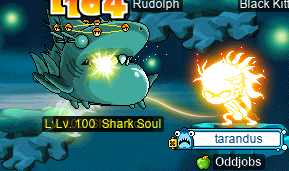
With
- 10 Captured Bone Fish Souls,
- 10 Captured Goby Souls,
- 10 Captured Squid Souls,
- & 10 Captured Shark Souls,
I now had what I needed to get Carta to make a curse-cleansing brew.
Ok, it’s ready. Now place the bird in the cauldron. Don’t worry, it’s nothing dangerous. Just a quick dip in a cauldron full of lost souls.
Oh dear. Thankfully, it did in fact turn out to not be dangerous, although Albatross made a bit of a mess by splashing about in the cauldron.
For better or worse, however, the brew did nothing. Albatross had no curse to begin with, & thus no curse was lifted. Upon learning this, Muse finally came to accept that Albatross was simply depressed. Without the ability to fly free, to explore the world, & to live their life, Albatross was never going to be satisfied.
So, Muse had an idea: considering that I’d already bonded so closely with Albatross on our many adventures, Muse was willing to let Albatross free from the Zoo, with me as their guardian. After quizzing me about the aforementioned many adventures, Muse said her[5] goodbyes to Albatross:

What a cutie. I’m gonna have to scroll a pet equip for this little birb!
My mini-review of The Albatross
I did a little review of the main questline of tier I in the “My little review of The breaking of Arel” section of the previous entry. Most of my comments there also apply to The Albatross, as the two are fairly consistent.
The Albatross is very good.
As far as NPC dialogue writing & style goes, I think that The Albatross suffers a little bit from the kinda samey NPC attitudes/conversational styles seen in The breaking of Arel. For instance, Carta is notionally portrayed in the same way that she’s characterised in Wizet’s pre-Big-Bang quests that involve her: she’s kind of an “evil witch”, but more vindictive or simply standoffish than actually cruel; she views humans as foolish at best, but humans find themselves needing her assistance when her occult superpowers & knowledge become necessary. That’s enough of a description that we can already imagine that she has quite an attitude. The Albatross does a decent job with it, but given that Carta is kinda the “spiciest” character that shows up in the entire questline, for me personally, it leaves something to be desired. I want more sass!! More cheek!!! More insults!!!!
Anyway, my other minor criticisms of The Albatross are also… minor. The invisible NPCs are a bit weird, & definitely need to be NPC-chat-buttonable. One of the quiz questions at the end is poorly worded enough that the apparently second-best answer is supposed to be the correct one. Yadda yadda yadda…
Everything else
Just like with tier I, the main questline is only one part of the tier. The rest consists in a “test” from one’s 1st-job instructor, plus the completion of at least three optionals.
“The Test of Skill”
Last time, I was quite critical of “The Test of Strength”. This time, Kyrin attempted to get my hopes up:
Pirate! Look at you, your fancy knuckler, and your high damage!
I appreciate the compliments, but that “fancy knuckler” is just my hand.
How does it feel, to be so good? Eh? Haha, I’m just kidding, don’t worry! You’re not.
Okay, rude…
Treasures and defeated sea creatures won’t come at your feet just because you can slam them hard. Especially not if you don’t take a moment to breathe and recharge your own energies, every now and then! That’s called making good use of tactics, and of your brain!
Oh…? I’m listening…
That’s it! This is what we’re gonna train on. Go ahead and recover 10.000.000 HP with Energy Drain.
Oh.
Well, this time, the damage that I have to deal is couched in “healing” rather than damage — if we conveniently ignore the fact that these two are actually just linearly proportional so long as I don’t over-heal — so there’s at least nominally a reason why I have to use ED specifically…
Grab-bag of optionals
Like last time, I’ll leave a brief comment on each:
- 10 Capt. Latanica kills.
- Okay, makes sense. In keeping with the nautical theme, too, even if Singapore & the Aqua Road are completely different places.
- 5 APQ clears.
- Way better than attending five weddings…
- 10M mesos spent buying from NPCs.
- What?
- 10 unique maps around Aqua Road visited.
- Easier than the Victoria Island version, for obvious reasons, but still fun!
- 10 60% scrolls passed.
- What?
- 5 Orbis Rock Scroll or Eos Rock Scroll quest completions.
- Sure.
- 10 Faito item exchanges.
- Uhm… alright.
- 1k pet closeness earned.
- Albatross!
I am confused
Perhaps the most notable thing about tier II’s optionals is that it makes you realise how weird the UI for optionals actually is. Given that each tier is like its own questline, as a player, I naïvely expect them to be treated as such. In this way, each tier would have its own entry in a quest UI that lists completions, requirements, progress, &c., & for completionists, “old” tiers can continue to be active even after they’ve been passed.
In practice, HP Challenges have their own bespoke UI based not really on the built-in quest journal, but more on NPC chatting (with Rosa) via the @challenges command. This is fine, given that NPC scripts are much more flexible — indeed, plenty flexible! — anyway. However, when accessing the optionals through the @challenges UI, the user is in no way prompted to select which tier of optionals they intend to track their progress of.
Instead, as it turns out, optionals are actually categorised into eight categories, & each tier has exactly one optional that belongs to each category. The user may only have one optional from each category active at any given time. Thus, the optionals in each category from every tier — except for the tier of the optional in that category that happens to already be active… are you sufficiently confused yet? — are then hidden from the user. In order to make an optional active, however, the user must override the currently-active optional in that category, erasing any progress made on the optional being overridden.
The result is that, to start a new batch of optionals, the user must:
- Begin a new tier.
- Run the
@challengescommand. - Navigate to the optionals sub-UI of the
@challengesUI. - For each individual category:
- Select the currently-active optional in that category, bringing the user to an entirely new window.
- In the new window, select one optional from the category’s list that they want to be the active one, thus opening yet another new window.
- In the new-new window, confirm that they want their current progress in that category to be erased outright.
- Dismiss the new-new-new window that pops up, thus exiting the
@challengesUI entirely. - Go back to step (2.).
Not even to mention the bizarre need to erase progress throughout this process(‽), this UI is tedious & difficult to discover. I didn’t start my tier II optionals for a while, because I… didn’t know that I had to, & then when I got the idea that I did have to, I couldn’t figure out how to do it.
Who died and made you boss?
And that’s about it for this episode of Questin’ With tara™. I hope you enjoyed it! Or at least enjoy a little more borssing wif tarandybandy!
Like some more Qurecksselling with Lvl1Crook & some randos:
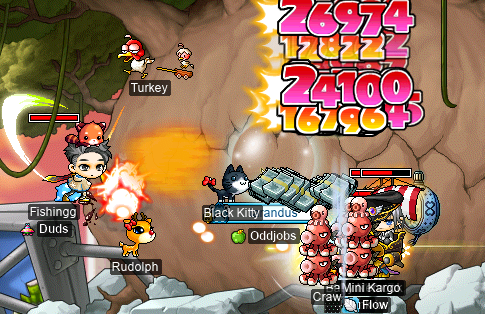
Or perhaps you have a bit more of a delicate taste, & prefer some more Rabanana with MiIf, Taima, & Harlez…?:
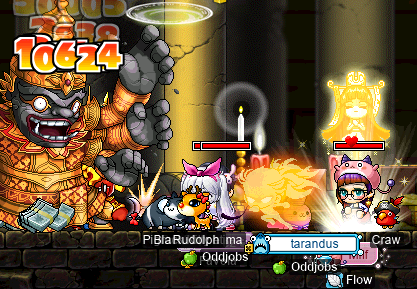
That’s Rabanana jelly, which is just one component of a standard P&RJ (that’s Papulatus & Rabanana jelly sandwich, for those of you following along at home). So we did a pair of Purple Ladles, as well:
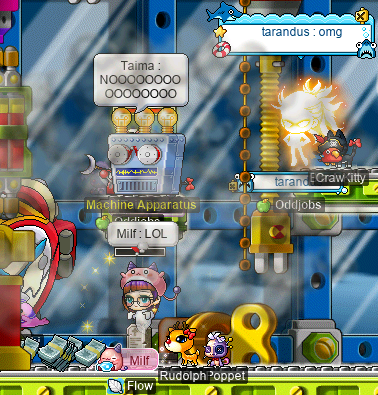
Remember, folx: your feet have to be in the Smoke! It’s like letting your feet stick out from under the covers; what if the monster under the bed comes out & bites your toes? That’s no good.
And finally, I saw some J’s[6] with Harlez!!:

🧡
Footnotes for “Our palms to the light”
- [↑] See the “In which MapleLegends is swallowed up by an arcade cabinet” section of pt. cv of this diary, & the “In which MapleLegends is digested within the rumen of the arcade cabinet… & spit back up” section of pt. cvi.
- [↑] Frequently known by the compound Panlid, not to be confused with the trade name Panlid™ (Domperidone + Pantoprazole).
- [↑] Cruise + cuisine = /kɹuˈzin/…?
- [↑] Or, as Mekhane (CaptainNemo, Sunken, FrozenNemo) calls them: Bone Fucks.
- [↑] Although I thoroughly appreciate Muse’s decidedly androgynous look, The Albatross takes after the O.G. questline Carta the Sea Witch in consistently referring to Muse with female pronouns.
- [↑] JC + -ing = JCing /d͡ʒeɪ̯.si.ɪŋ/ ∼ *J seeing. From MapleLegends’s corruption of 武林妖僧 (Standard Beijing Mandarin /u˨˩˦lin˧˥ jau̯˥səŋ˥/) as
Jiaoceng; see footnote #1 of the “A grasp nullary” section of pt. cviii of this diary.
(…cnvpstdf…)
cnvpstdf
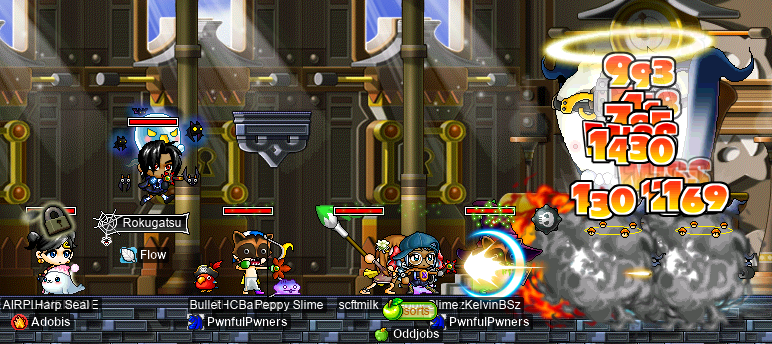
![]()
![]()
Transcription of the above image
syds [smega]: im a cat girl, whisp me for pics <333
[whisper to syds]: do you have any pics of just your cats

Transcription of the above image
[system message]: The item is destroyed due to the overwhelming power of the scroll.
vork: ur 30 luck is rly bad
LOL
axisaxis: ahahahaha

![hCaptcha: Please find and click on the letter W in the image below. [Challenge level: IMPOSSIBLE] hCaptcha: Please find and click on the letter W in the image below. [Challenge level: IMPOSSIBLE]](https://deer.codeberg.page/diary/109/please-find-and-click-on-the-letter-w-in-the-image-below.webp)
